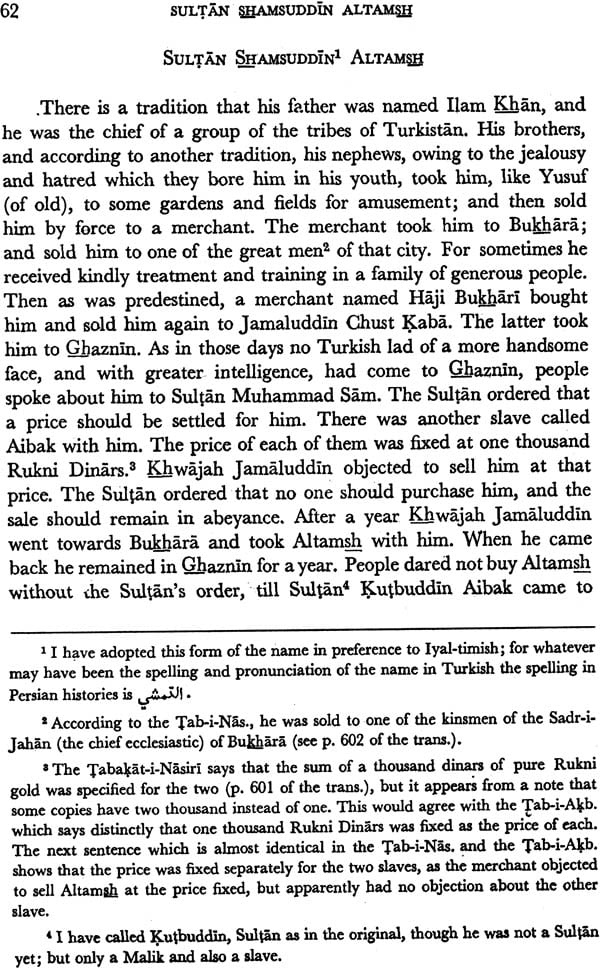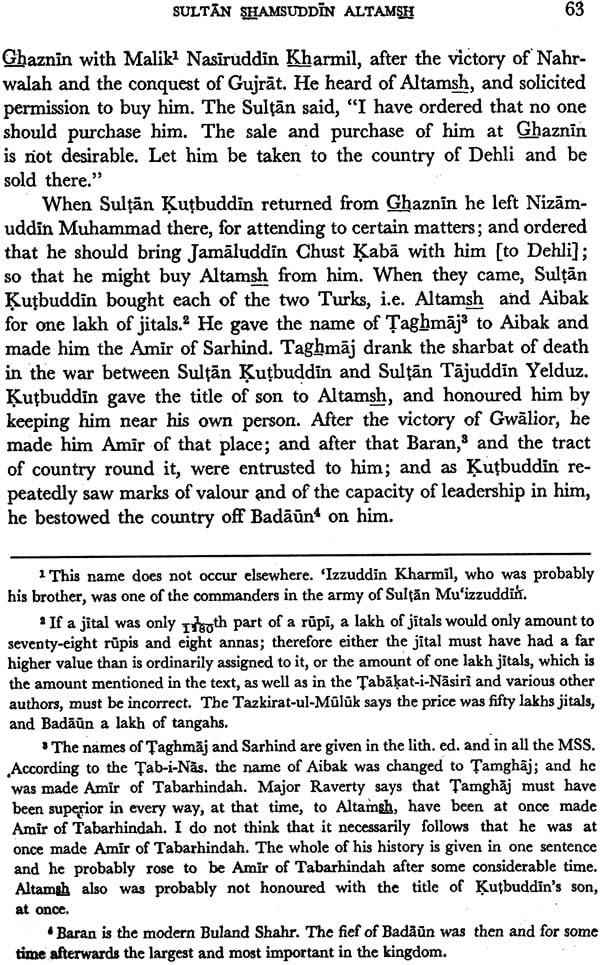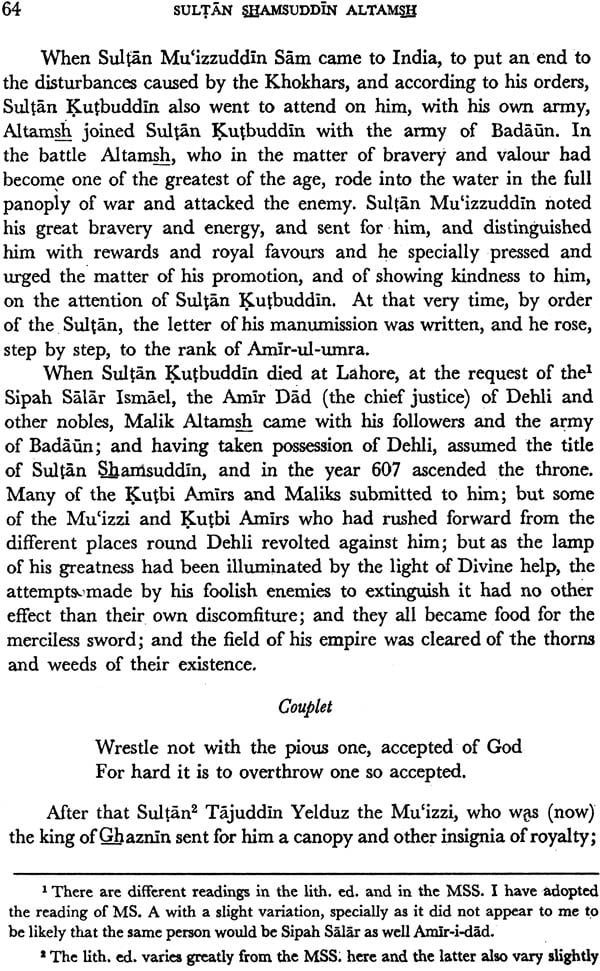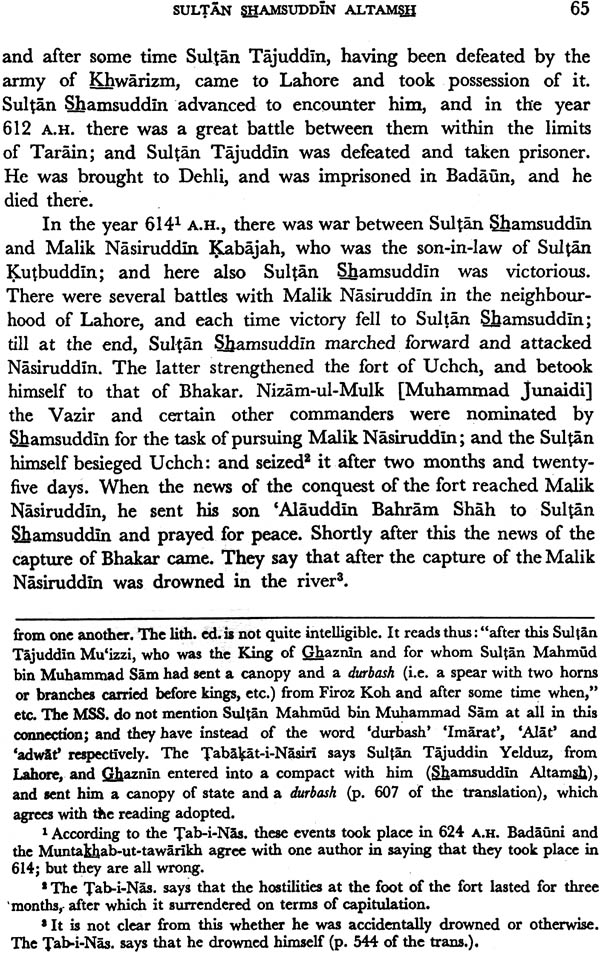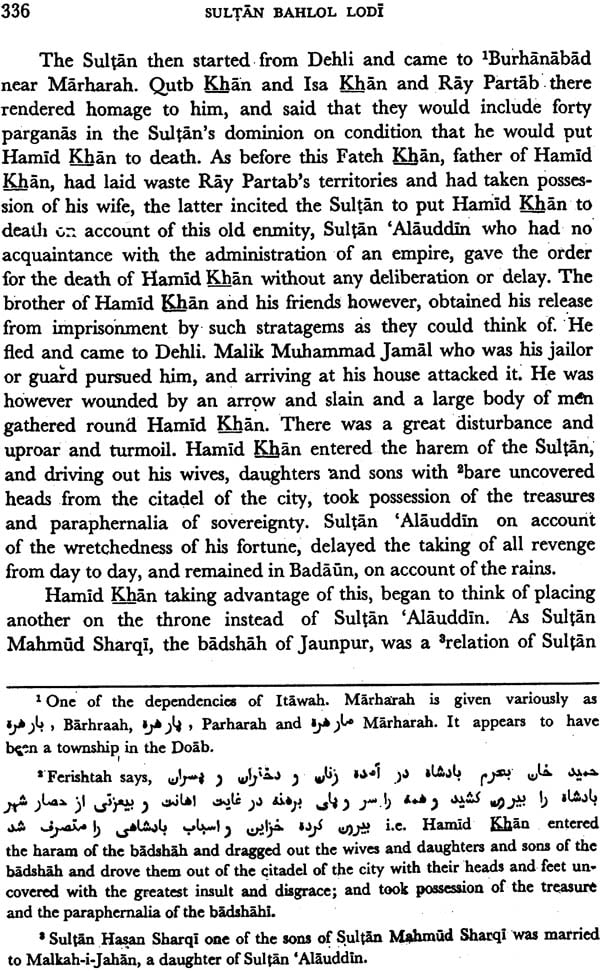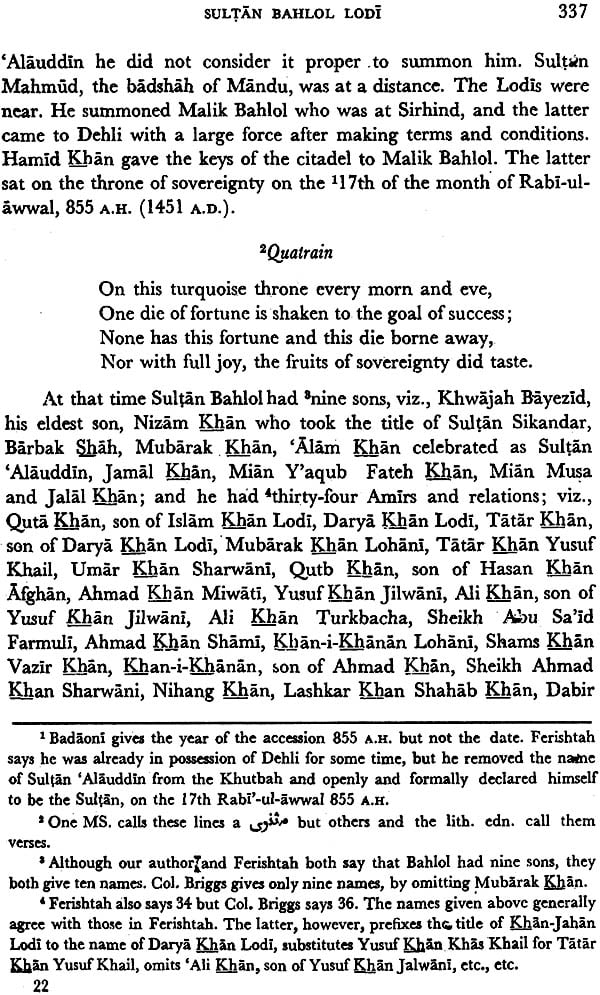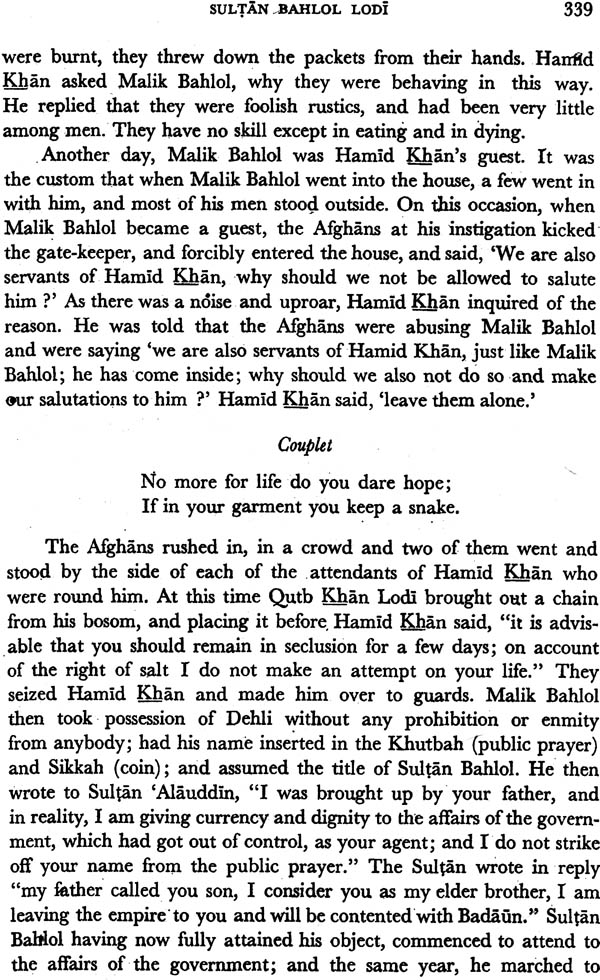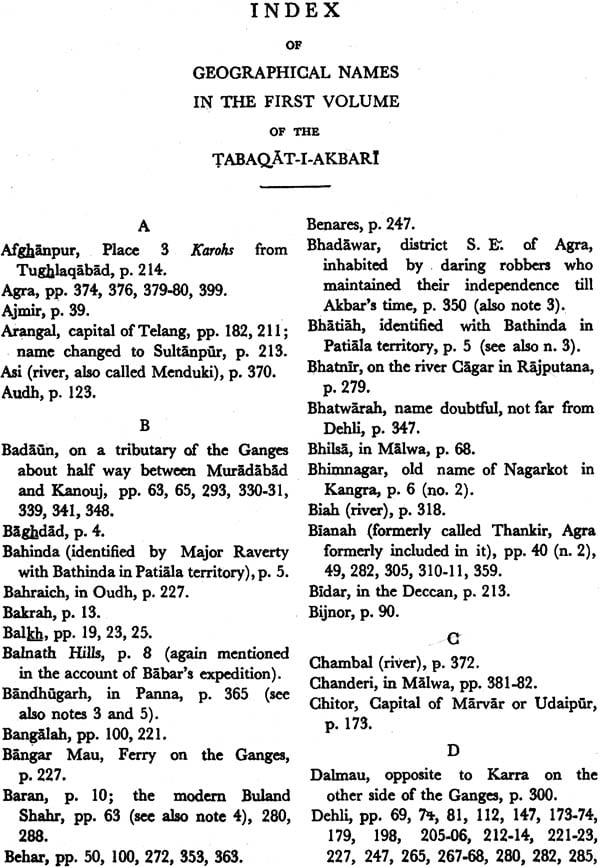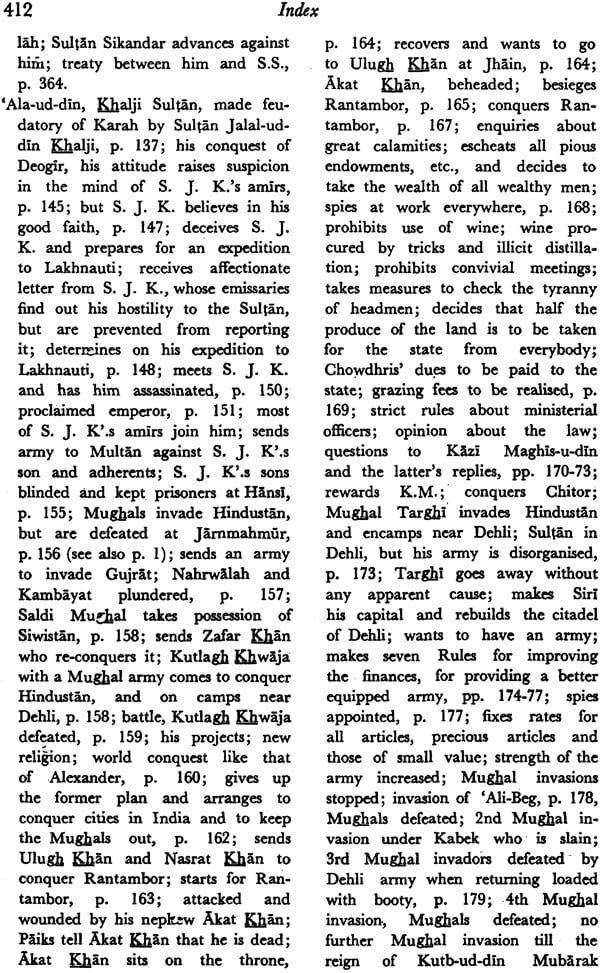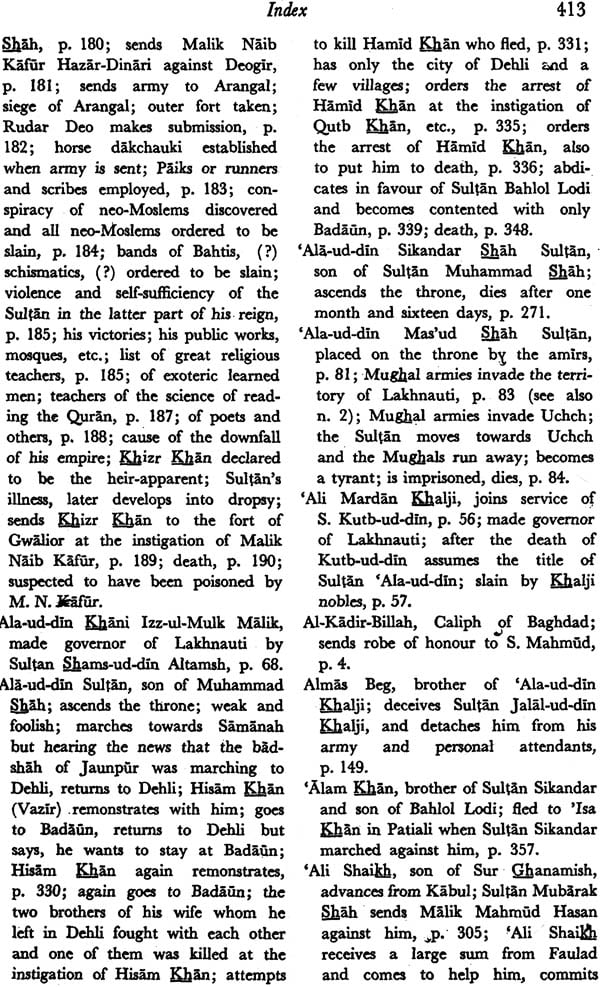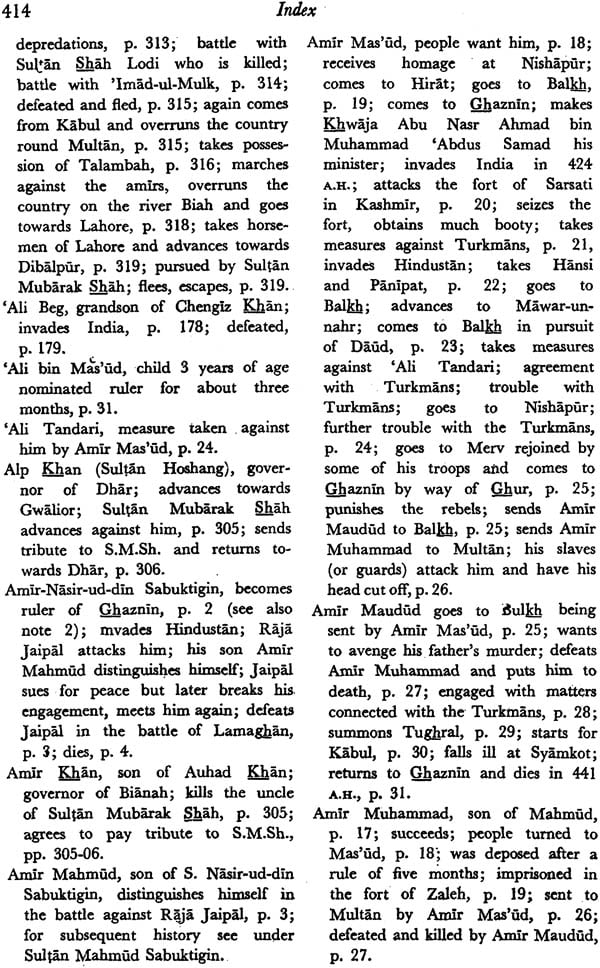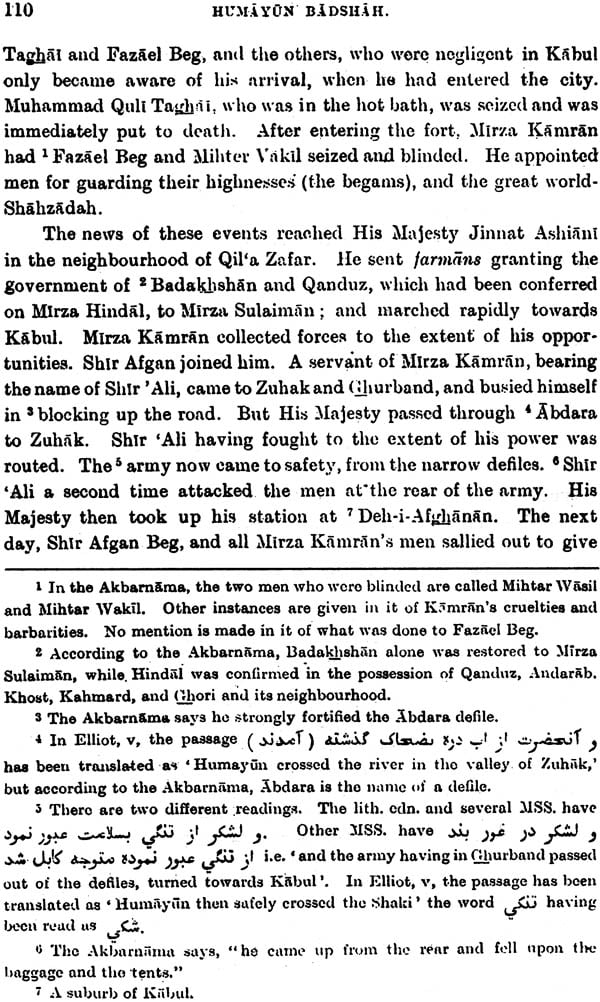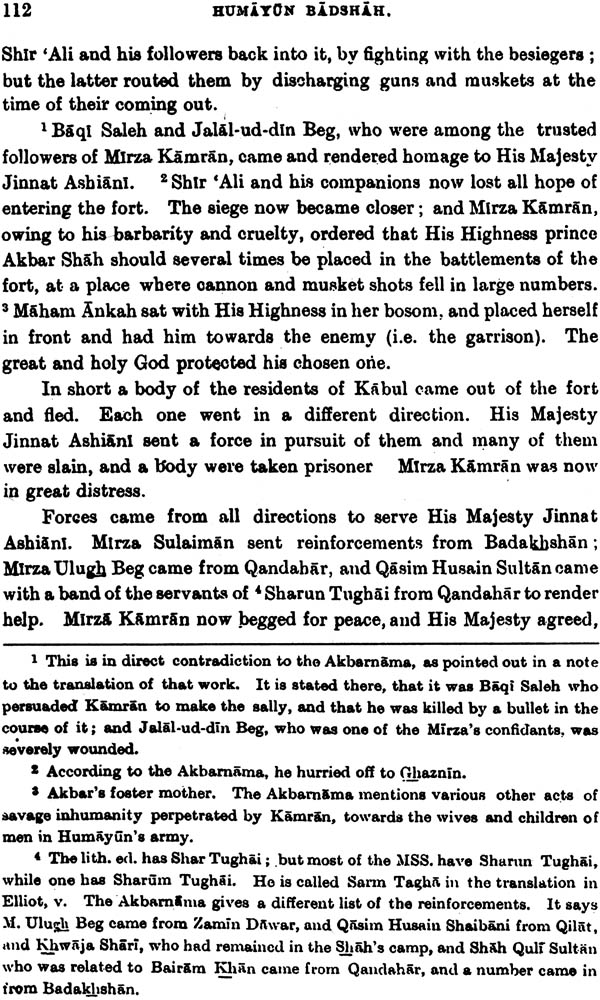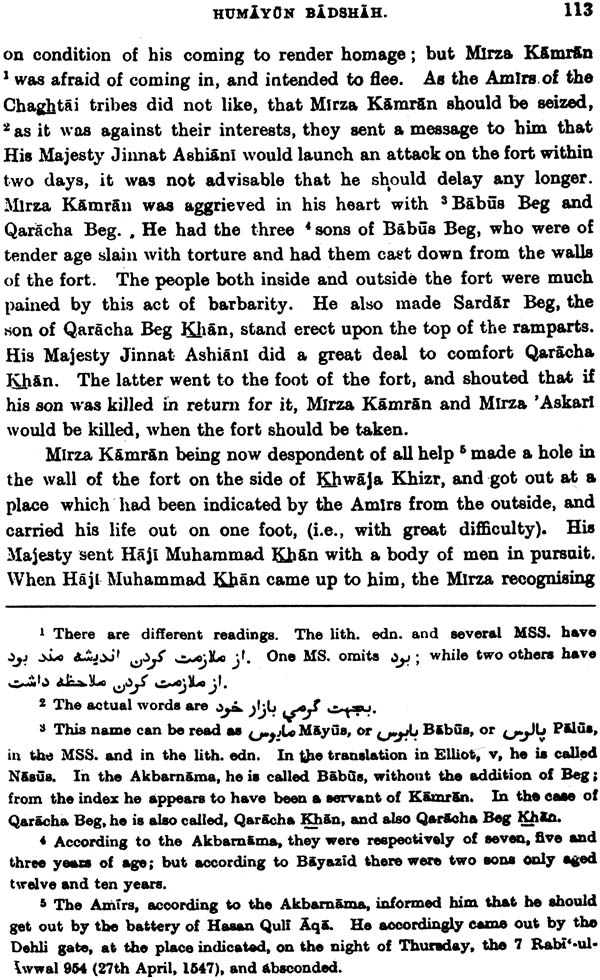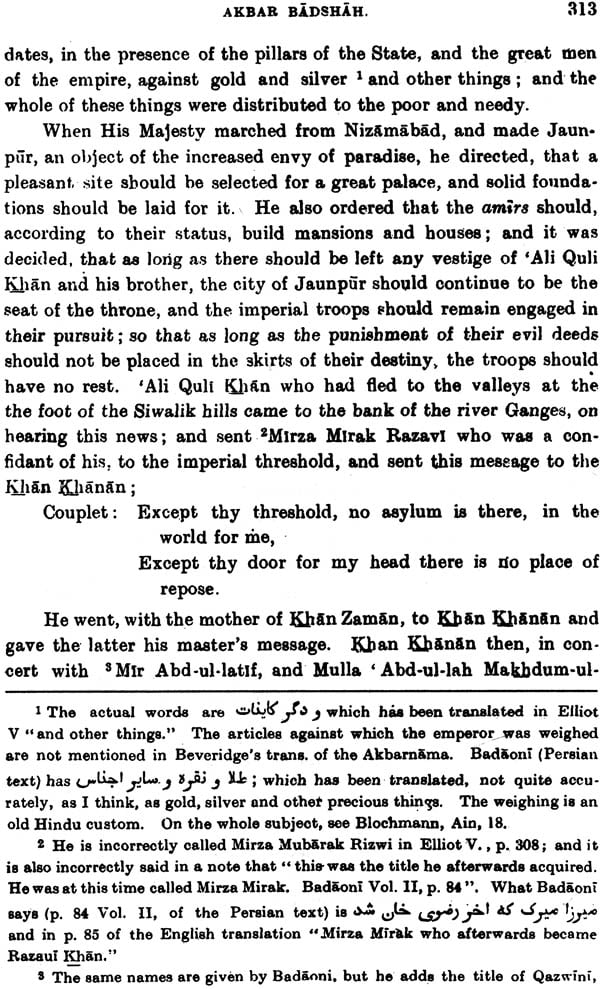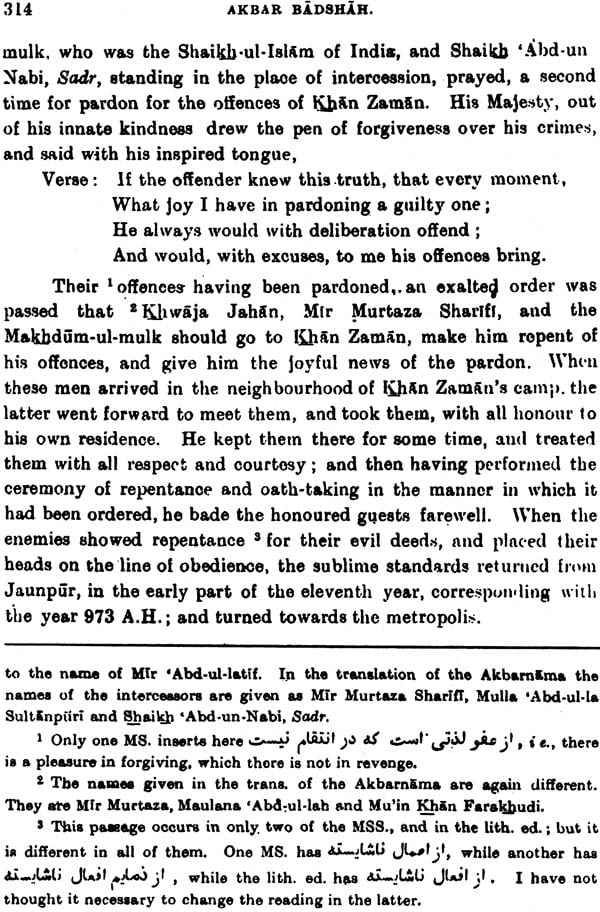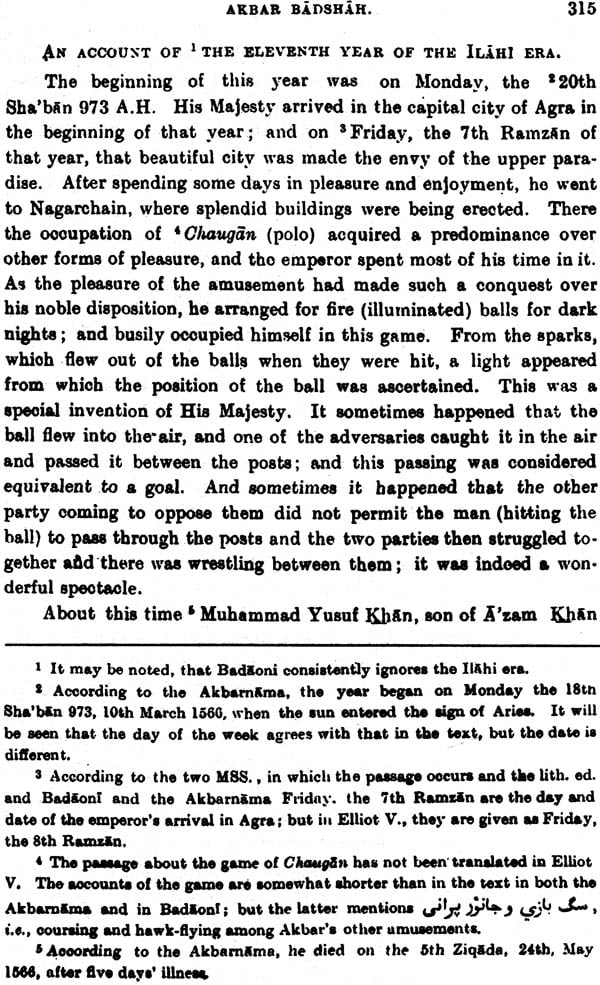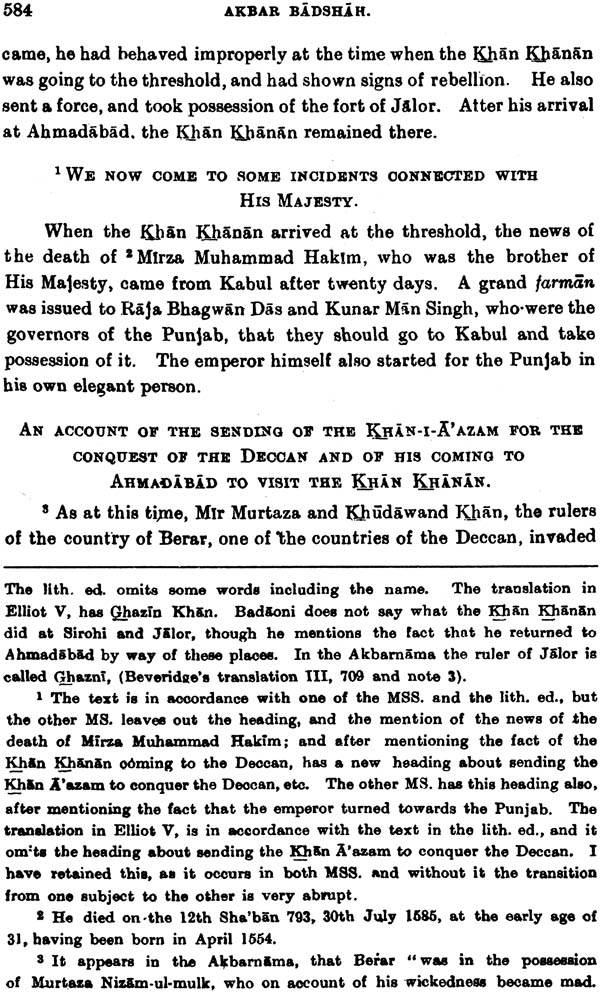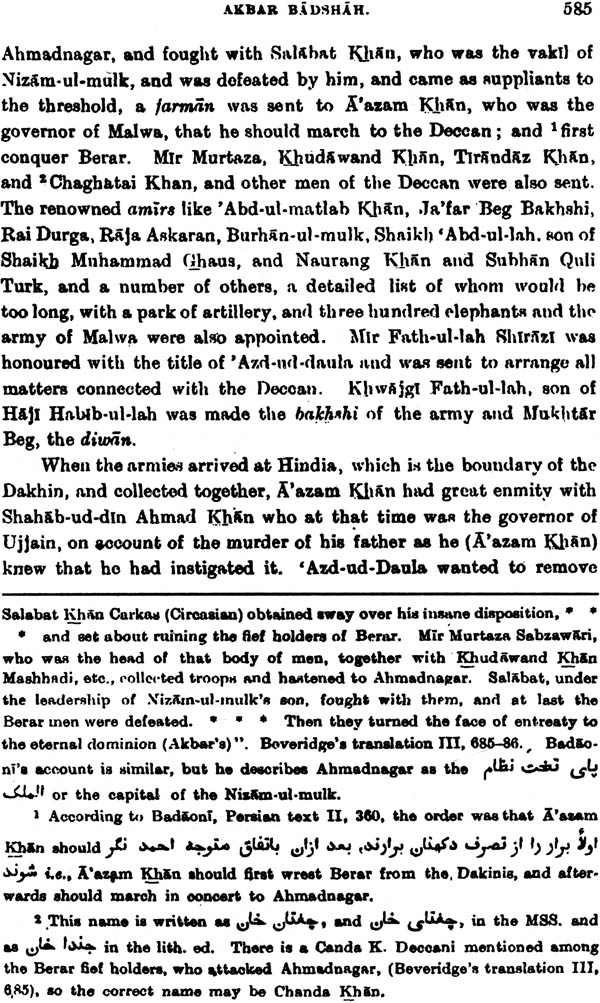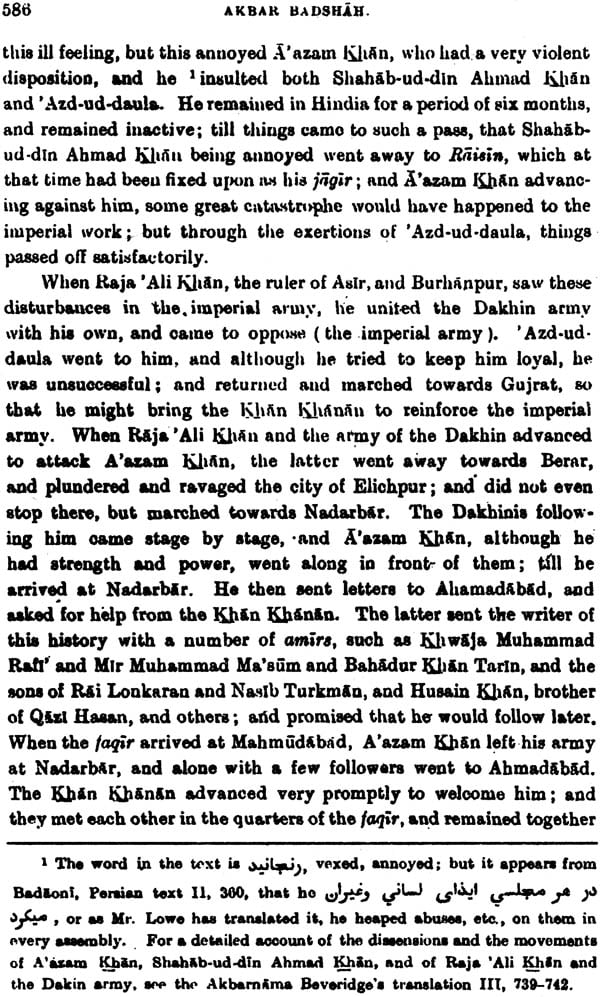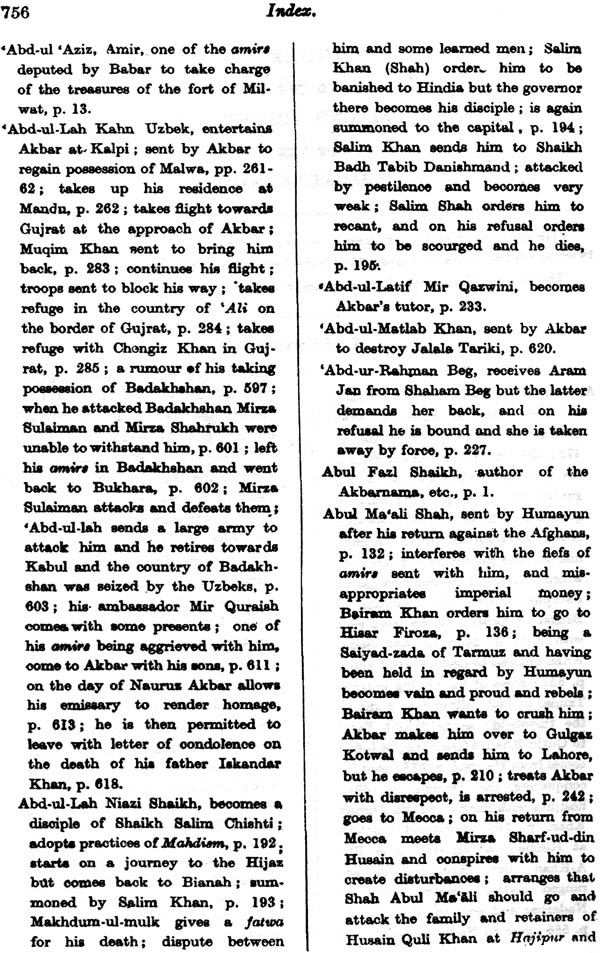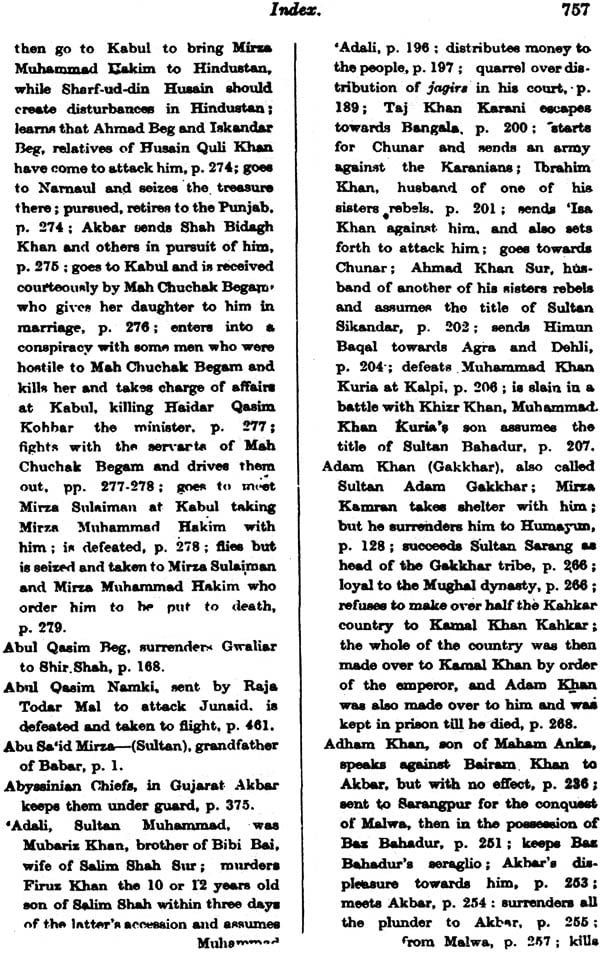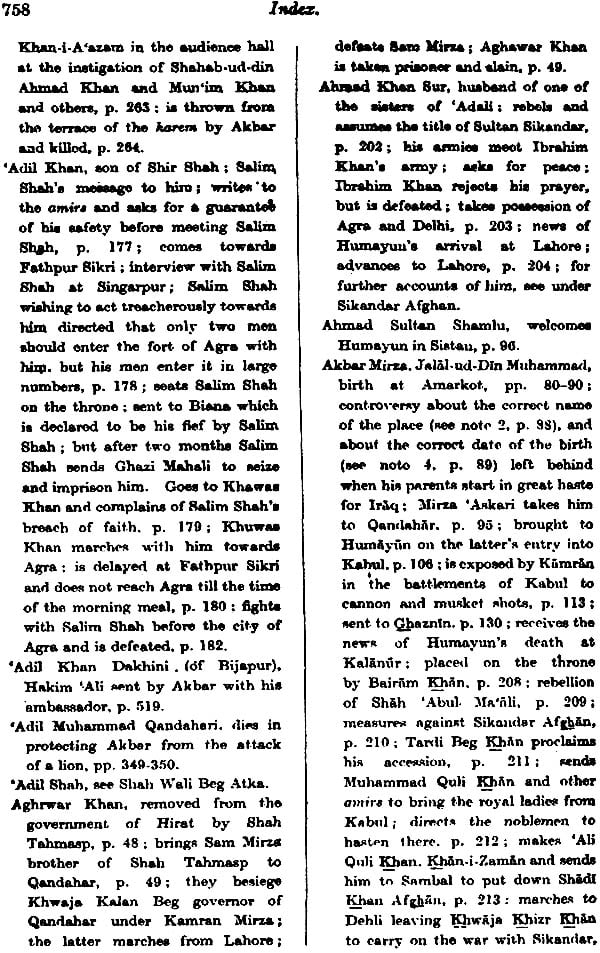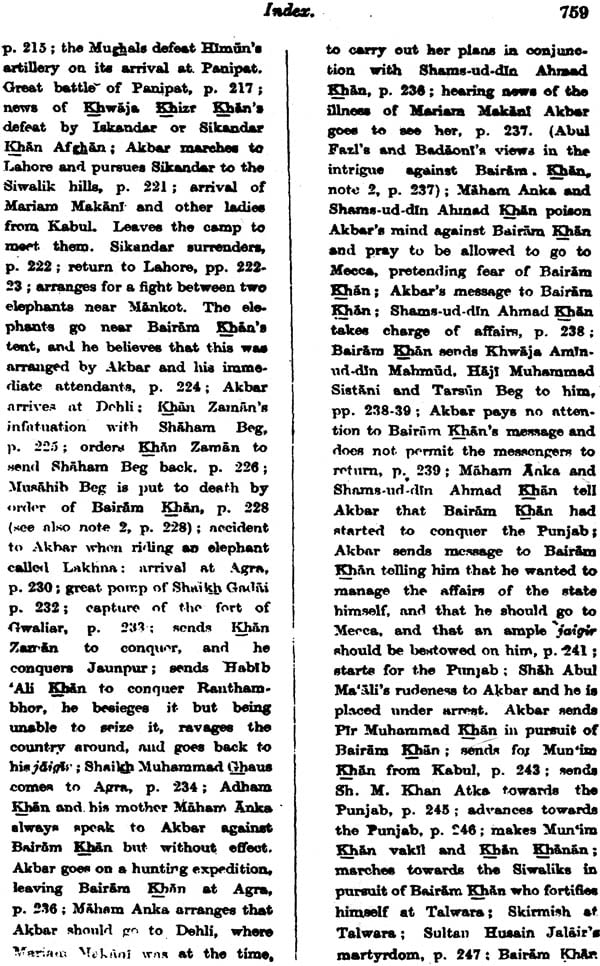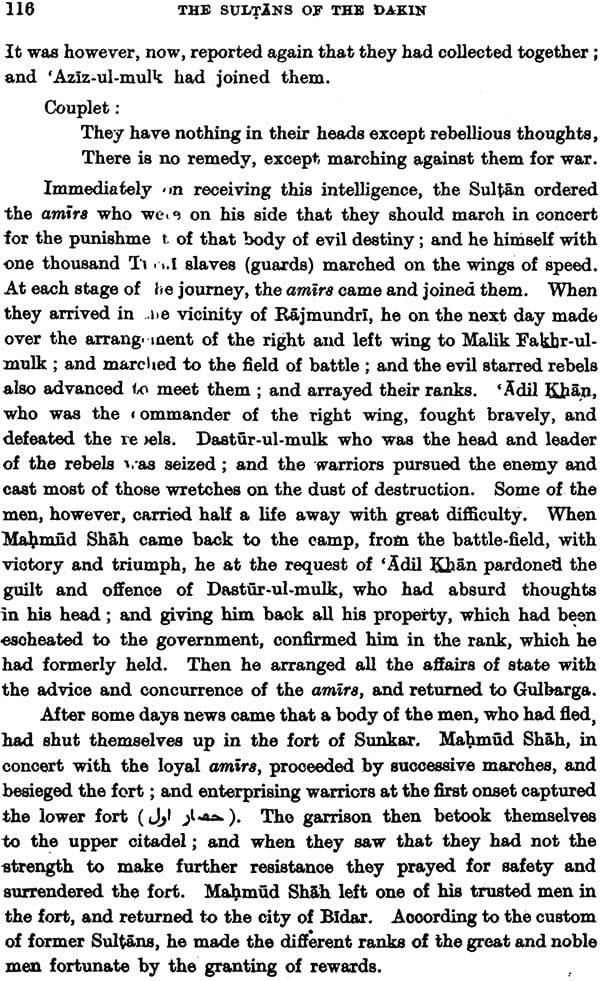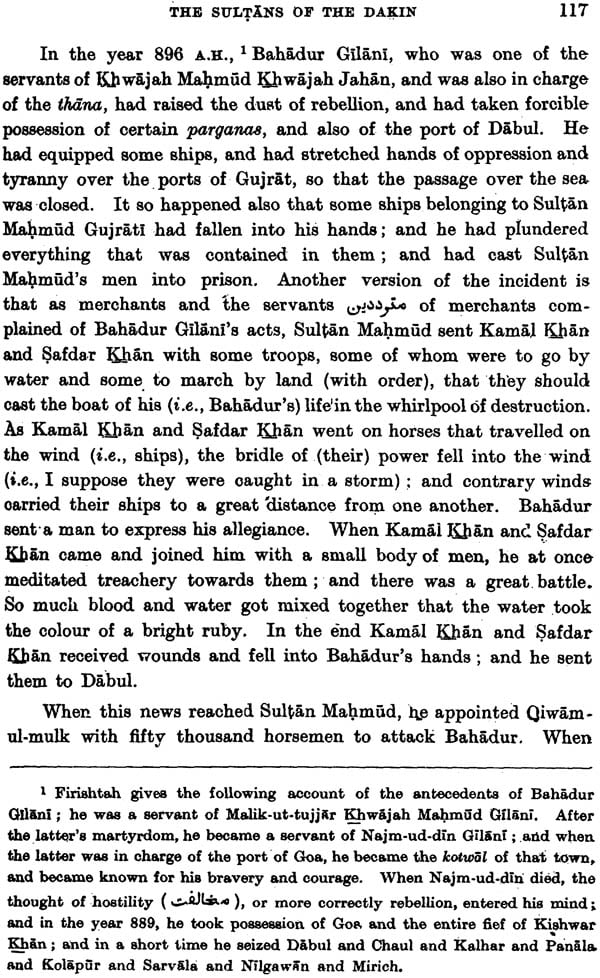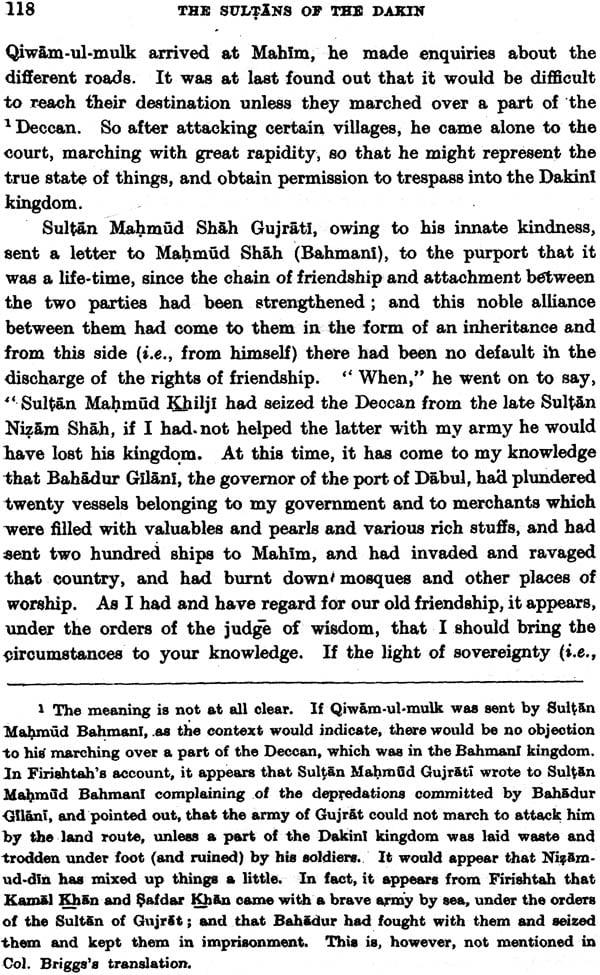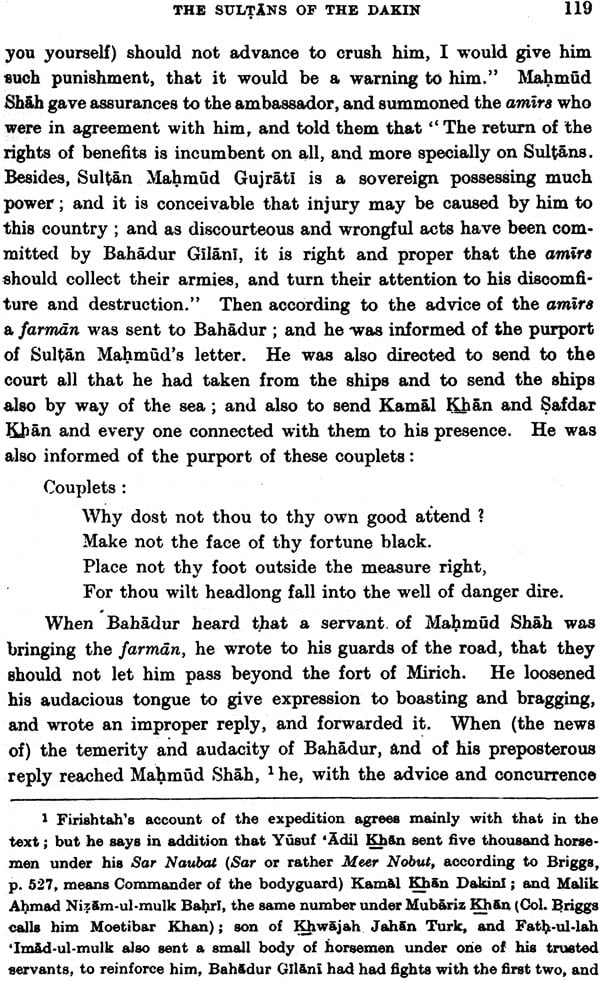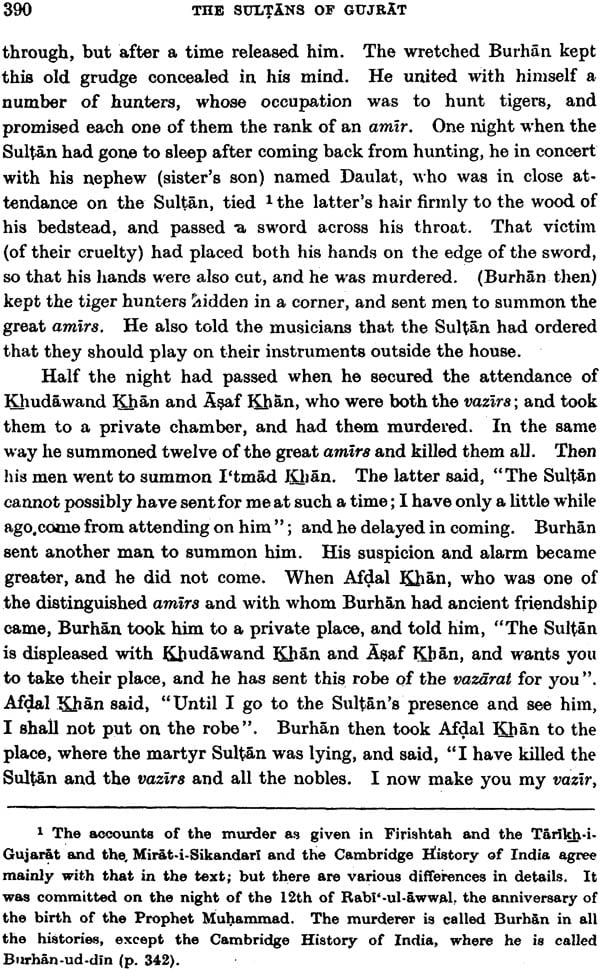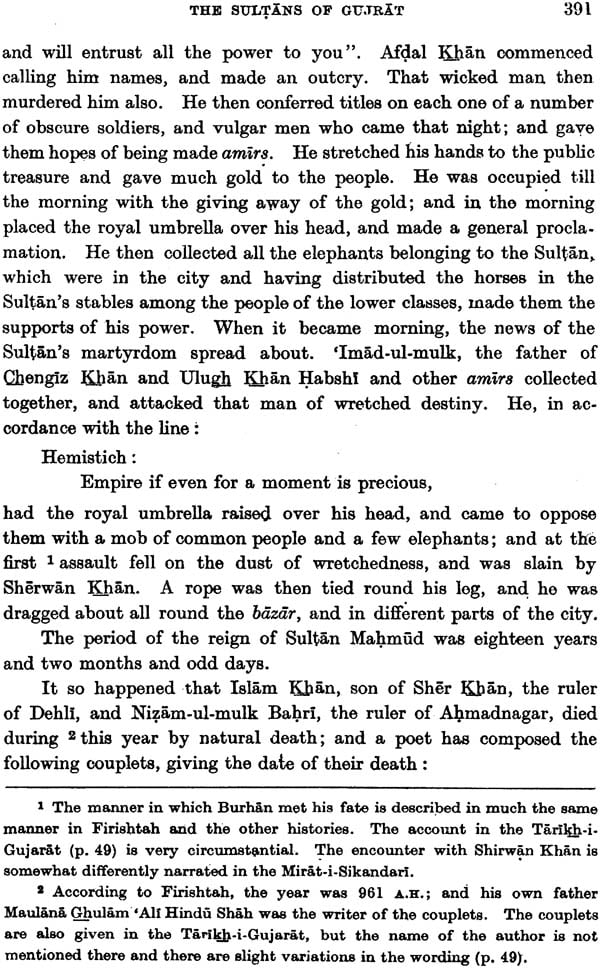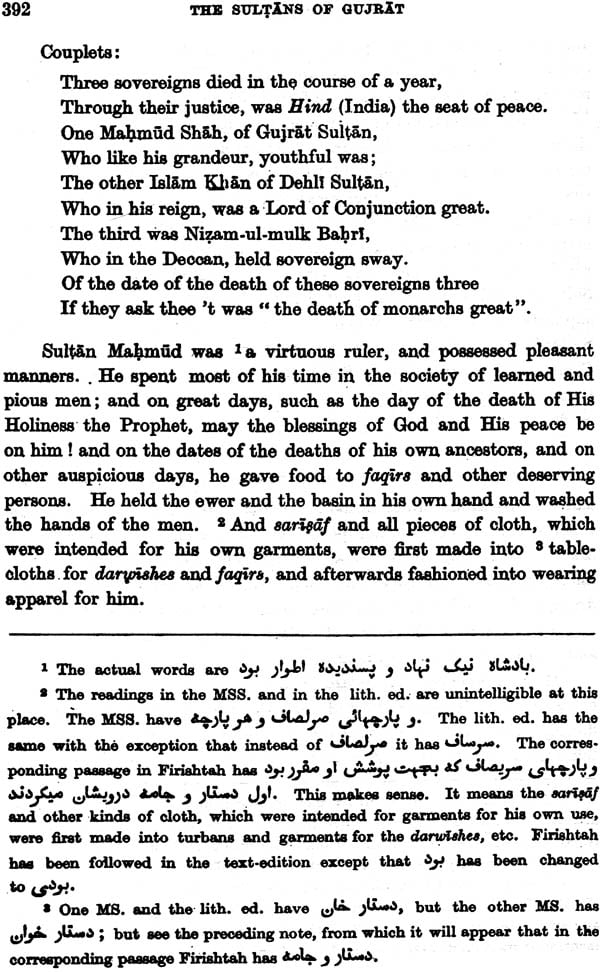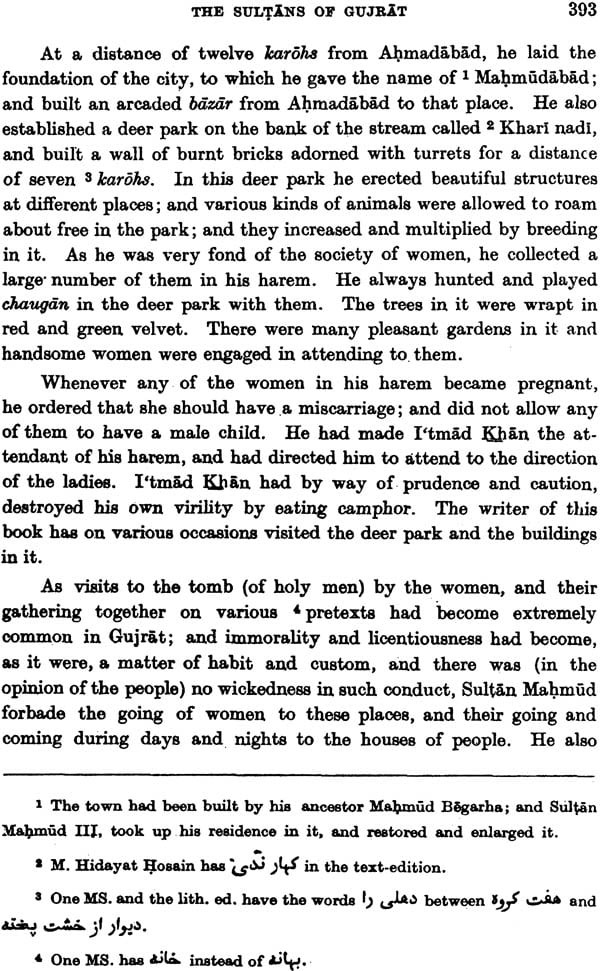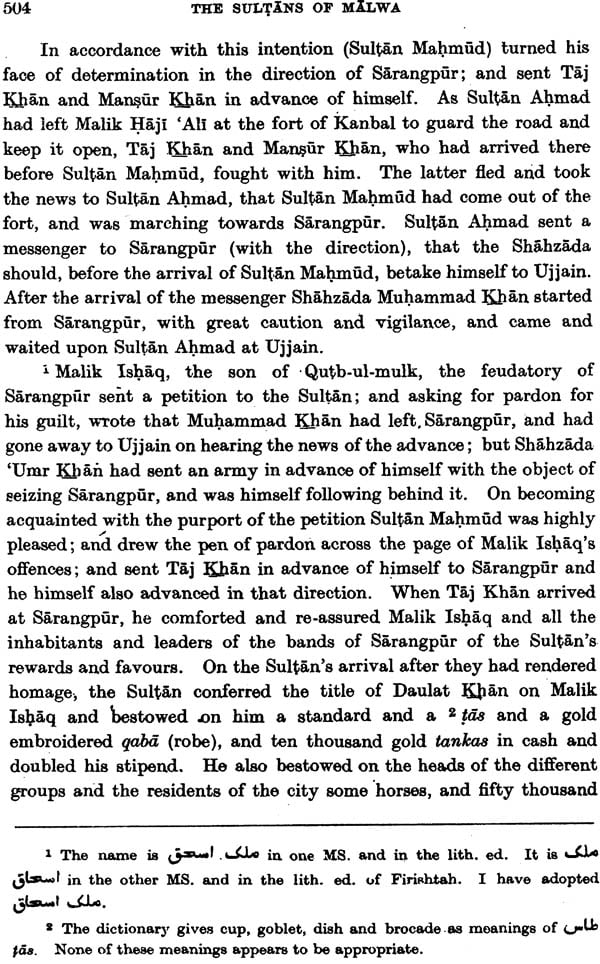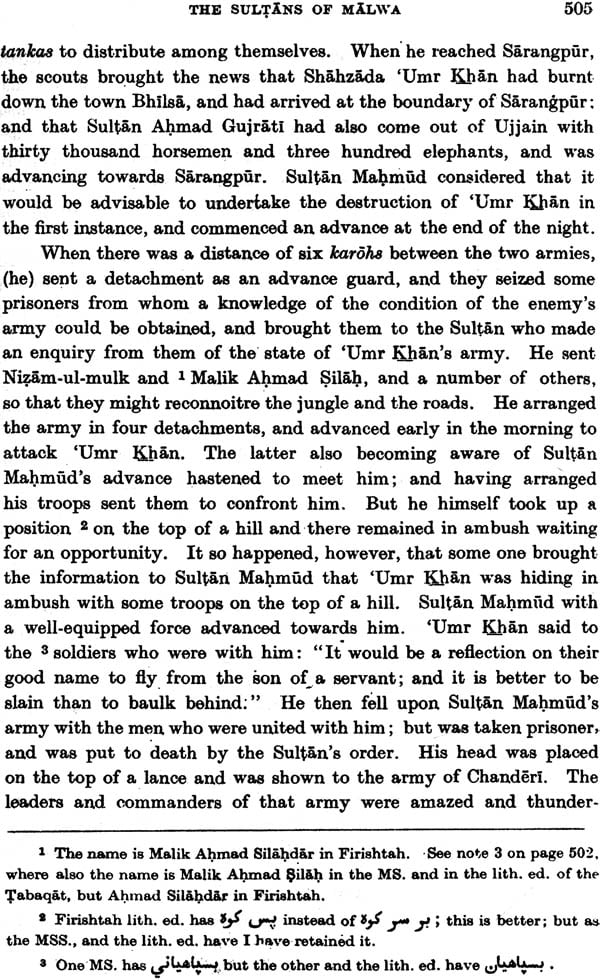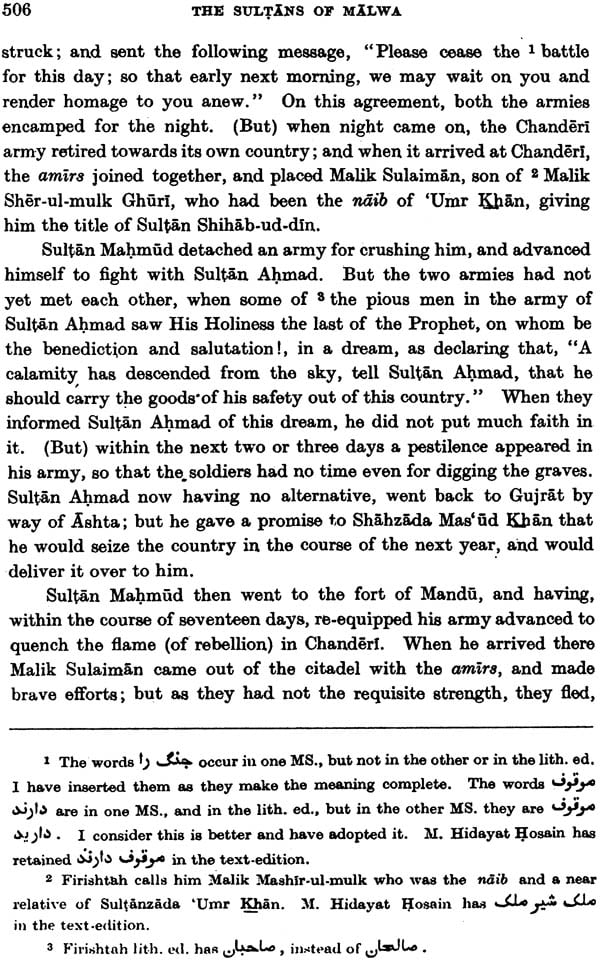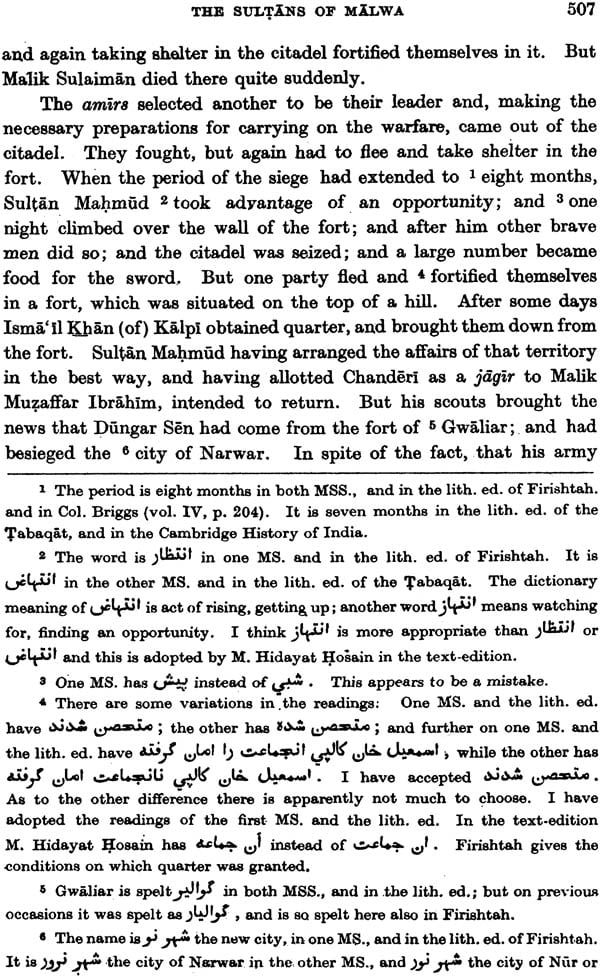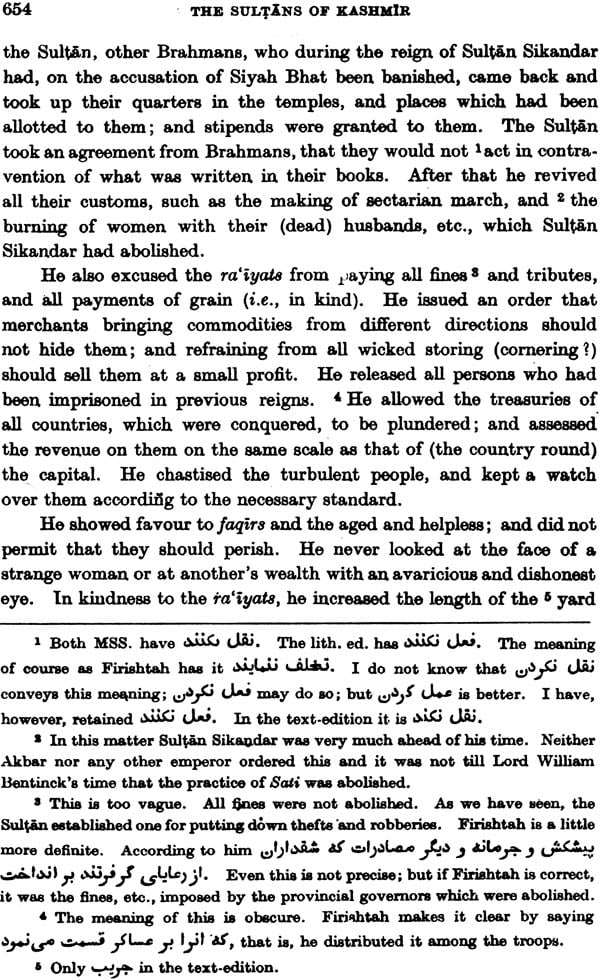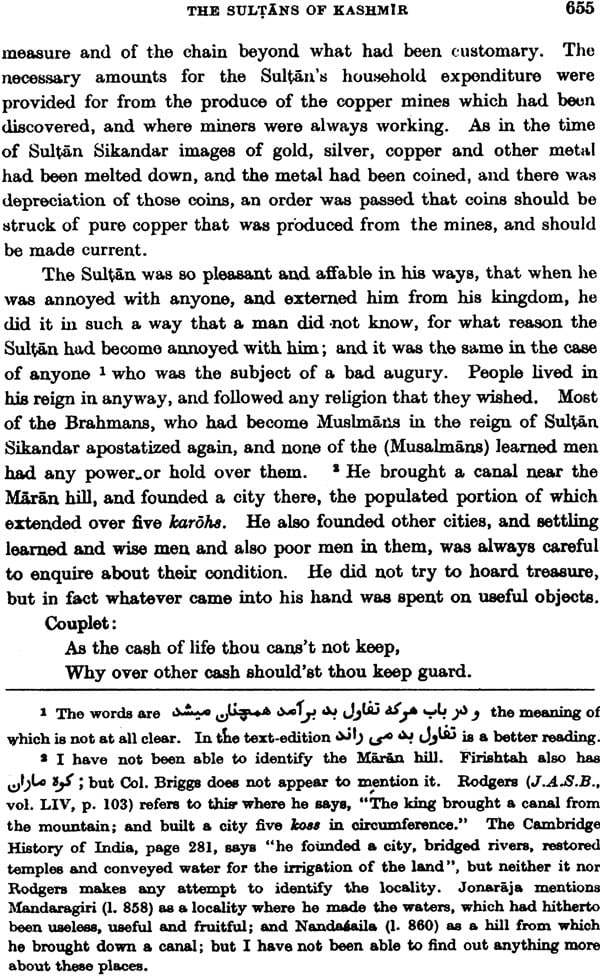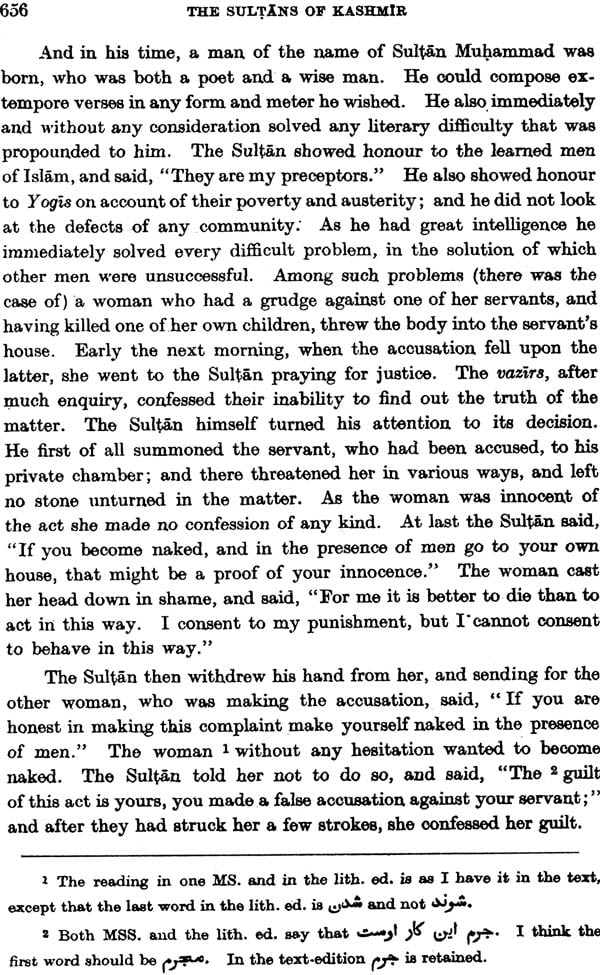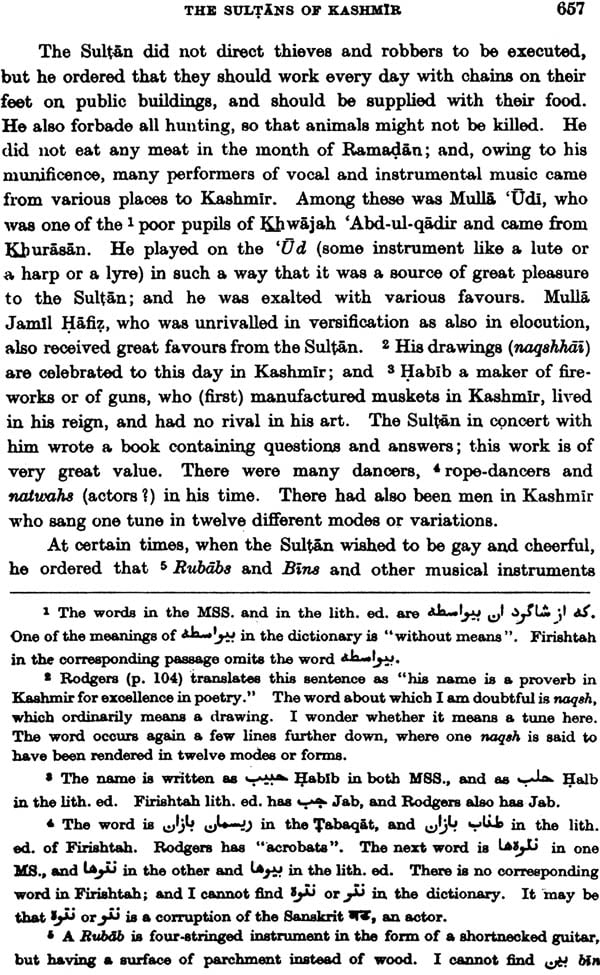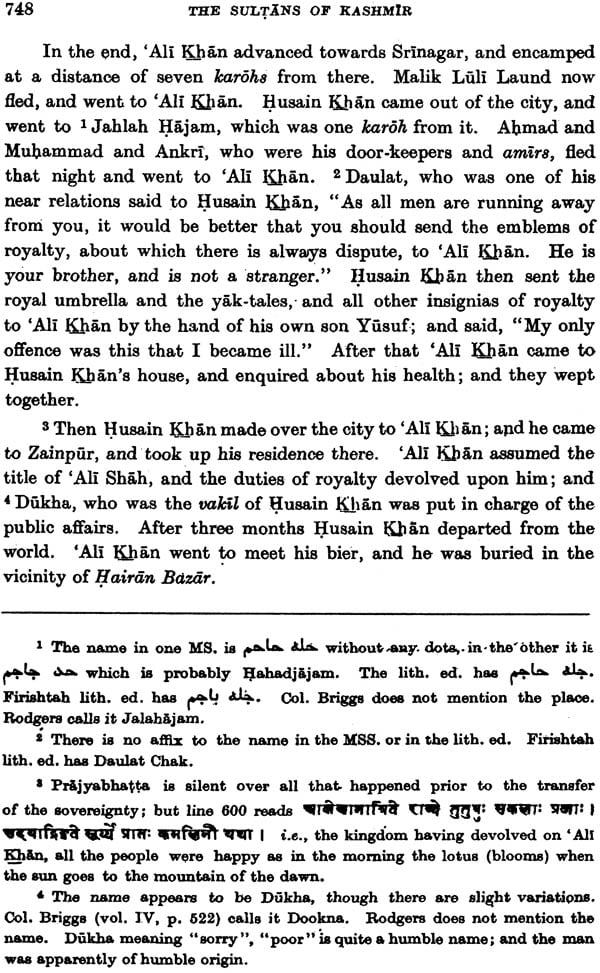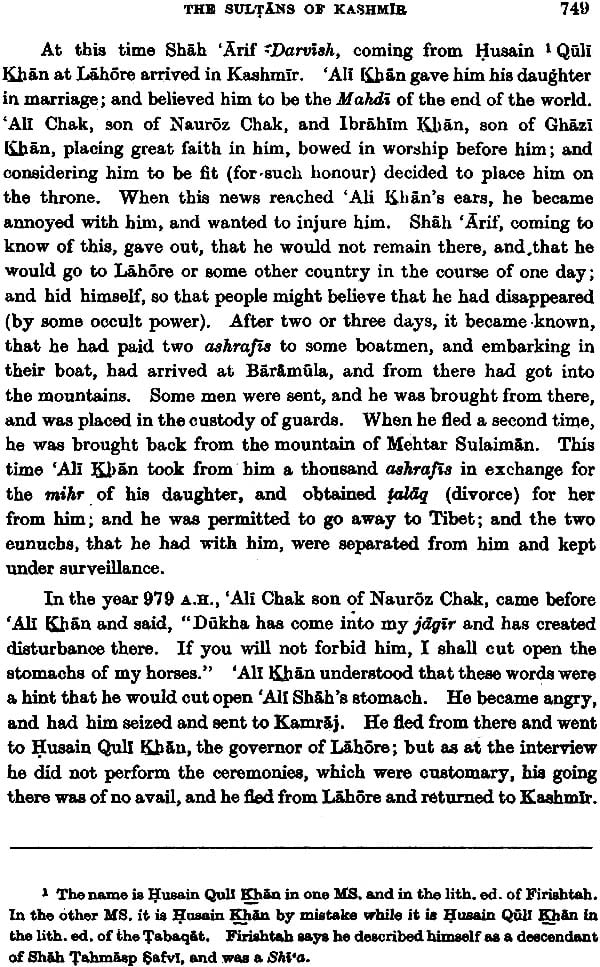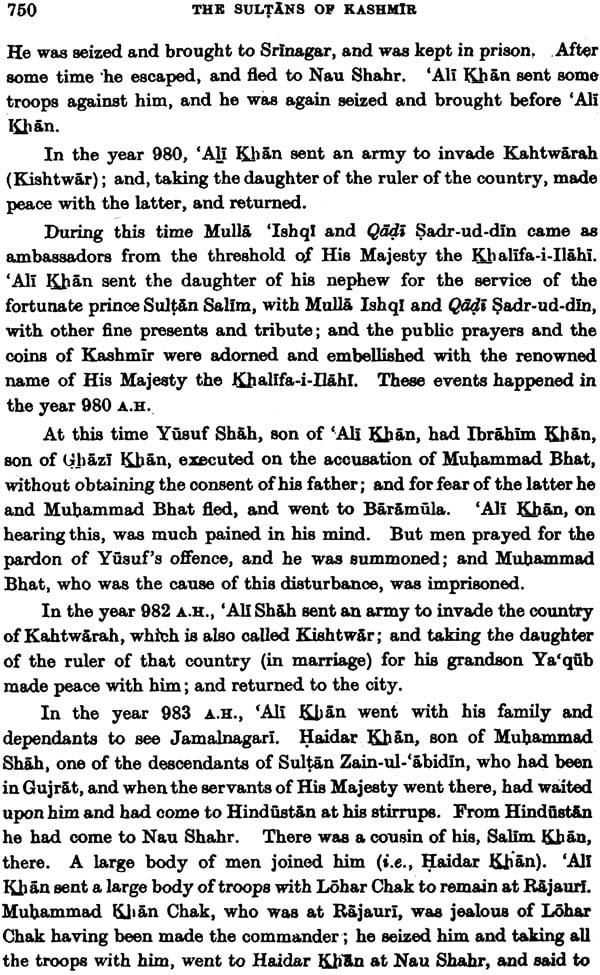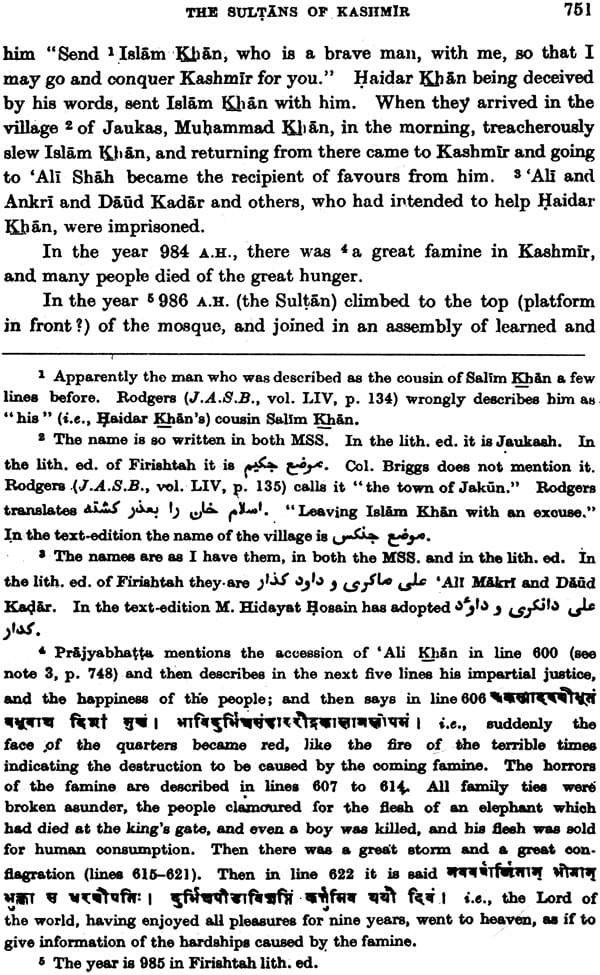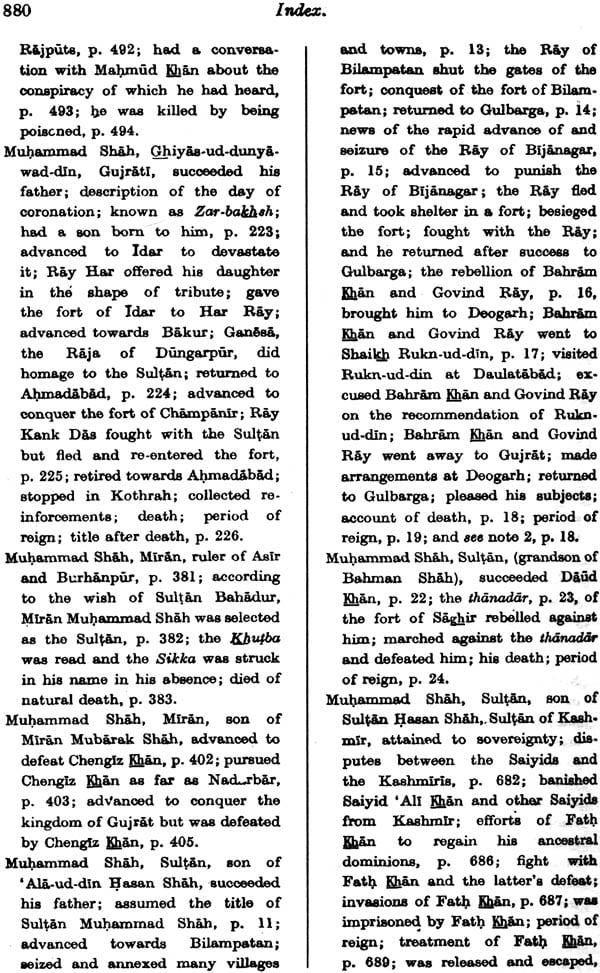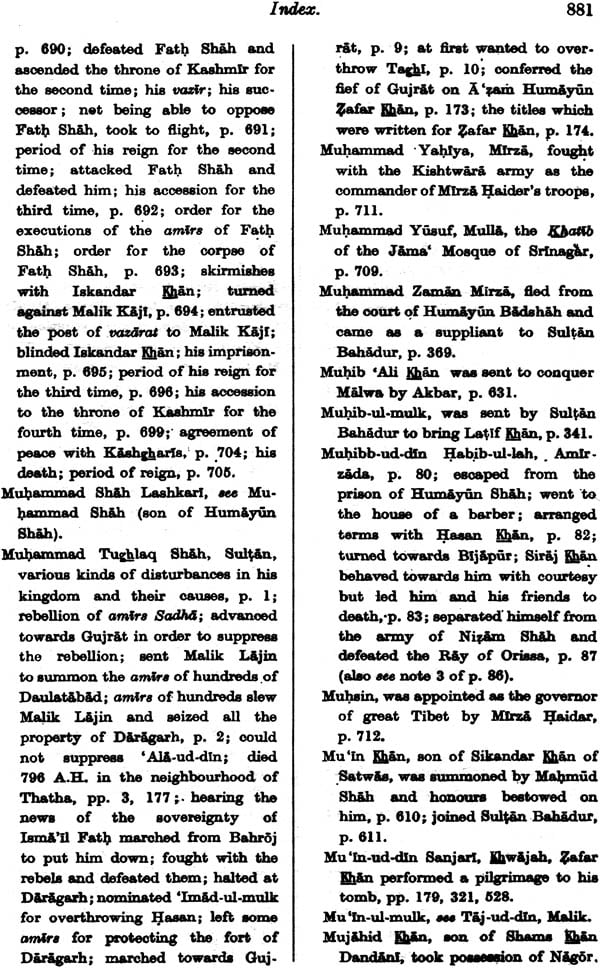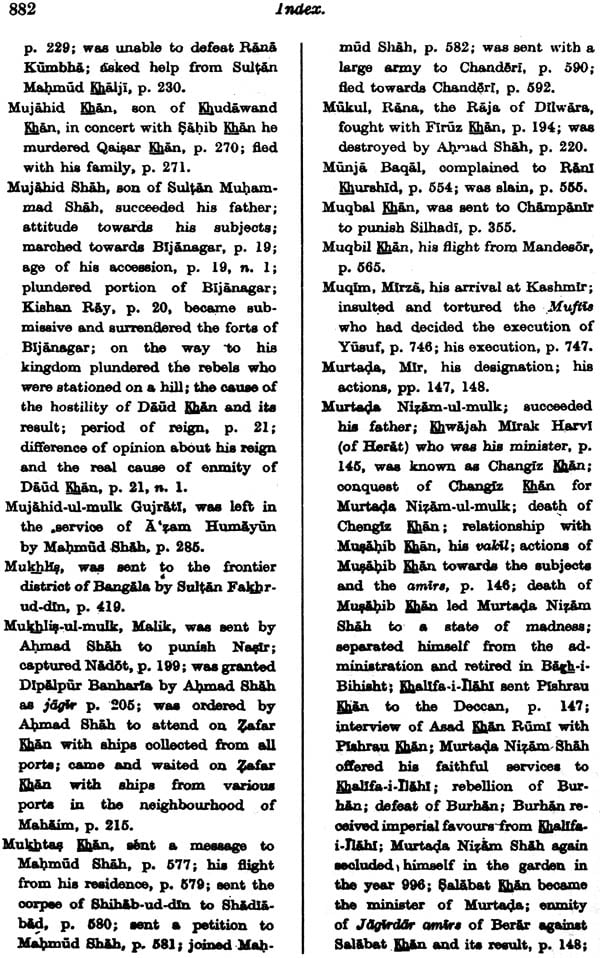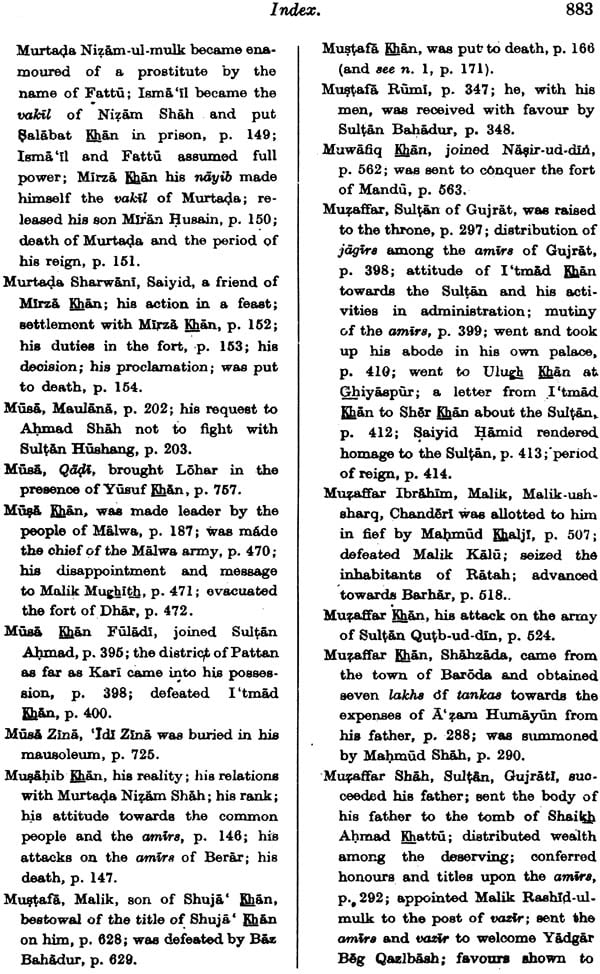
The Tabaqat-I-Akbari of Khawajah Nizamuddin Ahmad: (A History of India from The Early Musalman Invasions to the Thirty-Sixth Year of The Reign of Akbar) - Set of Three Volumes Bound in Two Books
Book Specification
| Item Code: | IDG236 |
| Author: | B. DE, M.A., I.C.S. |
| Publisher: | The Asiatic Society |
| Language: | English |
| Edition: | 2015 |
| ISBN: | 9789381574331 |
| Pages: | 2220 |
| Cover: | Hardcover |
| Other Details | 9.5 inch x 6.5 inch |
| Weight | 3.20 kg |
Book Description
Preface:
EMPEROR Akbar's love for history drew around him a number of reputed Persian scholars who produced valuable historical treatise. The Tabaqat-i-Akbari is one such authoritative account from the pen of Khwaja Nizamuddin Ahmad, who was not a professional historian but an experienced administrator with a keen historical outlook. It gives us a comprehensive history of India from the time of the Ghaznavides down to A.D. 1593-94. In consideration of its importance as a source book for the reconstruction of the history of medieval India, the Asiatic Society published the text in three volumes in its Biblio-theca Indica Series, edited by Sri. B. De between the years 1911 and 1941. Sri De also undertook English Translation of the text which again came out in three volumes during the same period. It will appear from the Translator's note that after publication of fascicle I of Volume I in 1911, the work was suspended till 1927 when the rest of it was taken up. The Volume I of the translation went out of print while the two other volumes are still in stock. In order to meet the sustained demand of the volume from scholars working in the field the Council of the Society decided upon bringing out a reprint of the particular volume only. It is a matter of gratification for me to be able to release the work for which our thanks are due to Sri Biram Mukhopadhyaya who assiduously corrected the proofs and saw the volume through the press. We deeply appreciate the cooperation rendered by the Iran Society, Calcutta, in permitting us to consult their copy of the book, as our own library copies even have been damaged by continued use by the scholars.
Though a new edition has been brought out we do not claim that we could revise it thoroughly, as much as we liked for obvious reasons. Discrepancies about spelling of proper names, and also in transliteration, which were there in the original edition could not all be remedied, but they are of minor nature and will not for that minimise the value of the book.
THE sublimest praise is due to that true King who has placed the making and unmaking of the government of the world, and the regulation of the affairs of the human race, in the noble existence of just rulers and wise administrators; and has treasured and entrusted the task of maintaining and enforcing the laws of religion and govern- ment in the greatness and grace, the generosity and sternness, and the mercy and wrath of these great men. And may prayers high as the throne of God rest on the leaders of the caravans that follow the straight path, and guide the foolish wanderers in the darkness of infidelity to the brilliant spaces of truth, and lead those who wander in the wilderness of confusion to the haven of fulfilment, by the aid of the glory of the Divine light and the help of the refulgence of the Divine nature; and specially 'on that most perfect specimen of creation, and that final embodiment of Divine aid and inspiration, whose sublime nature is a part of the Divine light, and whose noble essence a portion of God's holiness; of whose light the earth and the sky are a shadow, and of whose essence all space and creation a reflection; and [may similar prayers rest] on those who travel along the high- way of his will, and following him step by step reach the vantage ground of union.
But, after that, this insignificant particle-s-Nizamuddln Ahmad, the son of Muhammad Mukim the Harawi, who is a humble depen- dent and a faithful adherent of the sublime Court of the great Emperor, the Sultan of the Sultans of the world, the beneficent- shadow of God, the vicegerent of the Omnipotent, the strengthener of the pillars of world-conquest, the founder of the rules for govern- ing the world, the ruler of the world and of all who inhabit it, the lord of all time and of all that exists in it, the embodiment of Divine secrets, the personification of spiritual essences, the most potent conqueror and the most successful ruler, the lion in the wilderness of political and religious warfare Abul Fateh Jalaluddin Muhammad Akbar Badshah Ghazi ; may God perpetuate his domi- nion and empire, and fill the table of his justice and benefaction!- represents that from his childhood, according to the instructions of his worthy father, he occupied himself with the study of historical works, which brightens the intellect of the studious, and inspires the intelligent with awe; and by the study of the accounts of the travellers in the stages of the journey of existence, which is like a progress of the soul, rubbed off the rust of his nature.
And in this great land of Hindustan, which is a vast continent containing many climes, and which those who have calculated the area of the earth have estimated to contain a fourth part of its surface, at various times and in different quarters various rulers have acquired power and dominion, and having styled themselves Sultans, have ruled the land; and the writers of those periods having described the conquests and the government of those quarters have left memorials of them. In this way there are histories of Dehli, Gujarat, Malwah, Bangalah and Sind; and similarly separate histories have been written of all the provinces and parts of Hindustan, It is wonderful (however) that no history has been written by any of these writers which contains a complete account of the events which have occurred in anyone of the provinces. Nor has any history been compiled of the whole country of India and of its capital Dehli. The only work which has acquired any fame is the Tabakat-i- Nasiri in which Minhaj has given an account of the period which begins with the reign of Sultan Mu'izzuddin Ghuri and ends with that of Nasiruddin, the son of Shamsuddin, Again the period from the reign of Sultan Nasiruddin to that of Sultan Firoz has been dealt with in the history of Zia Barni. For the period extending from the reign of Sultan Firoz to the present day, during the greater portion of which great disturbances have taken place in this country, and the people have not had the good fortune to be ruled by any great kings, the humble writer has in spite of repeated searches only come across fragmentary compilations; and has not heard of any history which contains an account of the whole of Hindustan.
Now that all the Provinces and Divisions of Hindustan have been conquered by the world-opening sword of His Majesty, the vice- gerent of God, and the many have been unified into the one, and even many of the countries outside of India, which had never been acquired by any of the former great Sultans have become part and parcel of his dominions, and it is hoped, that the seven climes would become the abode of peace and quiet under the shadow of His Majesty's auspicious standard, it came to the dull understanding of the author, that he should, with the pen of truth and candour, write a comprehensive history which should present in a clear style, in its different sections, an account of the Empire of Hindustan from the time of Sabuktigin which began with the year 3671 A.H., when Islam first appeared in the country of Hindustan, to the year 10012 A.H., corresponding with the thirty-seventh year of the Divine era, which was inaugurated at the epoch-making accession of His Majesty, the vicegerent of God; and should embellish the end of each section with the story of the victories of His Majesty's glorious army, which is as it were an introduction to the sublime chronicle of renown; then he should give a comprehensive account of all the victories and events and occurrences of His Majesty's reign each in its own place. The details of these events are contained in the great history called the Akbar-namah, which that embodiment of all excellence, the learned in all truths and know- ledge, the personification of worldly and spiritual perfection, the favoured of his Majesty the Emperor, the most erudite Sheikh Abul Fazl who is the preface of all excellence and eminence has written with his wonder-inscribing pen, and has made a chronicle for all times.
This is a reprint of the second volume of Brajendranath De's edition of the text of The Tabaqat-I -Akbari of Khwajah Nizamuddin Ahmad. The importance of the work was realised by the Society in the middle of the last century, but it was not before 1911 that it was taken up by Brajendranath De. And it was first printed in 1936 by the Royal Asiatic Society of Bengal as part of its Bibliotheca Indica Series.
The book offers an account of India from the earliest days of Muslim invasion to the thirty eight year of Akbar's rule. It is not just an account of the events in a chronological order but complete with the observations of the amirs, the hakims and poets of that time.
I hope that this reprint will prove useful to all serious students of history.
The third volume of Brajendranath De's edition of .Khwajah Nizamudin Ahmad's Tabaaat - 1- Akbari was first issued in 1935 by Khan Bahadur M. Hidayat Hosain after the death of Brajendranath. The Royal Asiatic Society of Bengal entrusted Baini Prashad with the task of editing the work. But in view of the size of the volume it was decided to publish it in three parts and the first part was issued in 1939.
The second part of the third volume of The r Tabaqat - I -Akbari of Khwajah was also published by the Royal Asiatic Society of Bengal in 1939. It contains a detailed preface containing the lives of Kbwajah Nizamuddin Ahmad, and Brajendranath De who had translated and annotated the text. The preface to the second part is selfexplanatory and highlights the importance of the work for all serious students of Indian history.
I hope this reprint will prove useful to all such scholars.
The late Mr. Brajendranath De, as a result of sustained work for nearly 20 years, prepared a collated edition of the text of the T'abaqat-i-Akbari of Khwajah Nizam-ud-din Ahmad. The first half of the first volume of the text was issued in July 1911, and the final or third volume was completed after Mr. De's death on 28th September, 1932, by Khan Bahsdur M. Hidayat Hosain from his manuscript and issued in July 1935. The first two volumes of the English translation by the same author were issued in 1927 and 1936 respectively. The first 80 pages in page-proof and an unrevised and partly incomplete translation of the remainder of the third volume Was found amongst Mr. De's- papers, and the Council of the Roval Asiatic Society of Bengal recently requested the undersigned to edit and complete the work. It was hoped that the-undersigned would have the collaboration of Prof. M. Mahfuz-ul-Haqq in this work, but, this has not been possible, and for the work, as now issued, the entire responsibility must rest with the undersigned. The first 80 pages were printed as corrected and revised by Mr. De, and in the remainder the work of Mr. De has, as far as possible, been preserved. The under- signed has, however, to prevent errors and omissions. verified the entire translation and checked citations and references as far as pos- sible. Further, as no standard scheme of transliteration had been followed, it was thought desirable to follow a slightly modified form of the scheme adopted by the International Oriental Congress of 1894 for the transliteration of Arabic and Persian works.
In view of the size of the publication it was decided to issue the translation in two parts. The first part is now being issued, and the second part with a detailed preface and comprehensive indices to both the parts will, it is hoped, be ready for issue sometime during the year.
| The Asiatic Society 15 August 1973 | S. K. MITRA |
Volume I
| Page | ||
| Translator's Note | vii | |
| Author's Introduction | xi | |
| The Introductory Section: Containing an account of the Kings of Ghaznin | 1 | |
| 1. Amir-Nasiruddin Sabuktigin | 2 | |
| 2. Sultan Mahmud Sabuktigin | 4 | |
| 3. Jalal-ud-Dowlah Jamal-ul-Millat Muhammad, the Son of Mahmud | 17 | |
| 4. Abu-Sa'id Mas'ud Bin Yemin-ud-Dowlah Sultan Mahmud | 19 | |
| 5. Shihab-ud-Din wa Doulat, wa Kutb-ul-Millat Abul Fateh Maudud Bin Mas'ud | 27 | |
| 6. 'Ali Bin Mas'ud | 31 | |
| 7. 'Abdur Rashid Bin Mas'ud | 31 | |
| 8. Farrukhzad Bin Mas'ud | 32 | |
| 9. Ibrahim Bin Mas'ud Sultan Mahmud | 32 | |
| 10. Mas'ud Bin Ibrahim | 33 | |
| 11. Arslan Shah Bin Mas'ud Bin Ibrahim | 33 | |
| 12. Bahram Shah Bin Mas'ud Bin Ibrahim | 34 | |
| 13. Khusro Shah Bin Bahram Shah Bin Mas'ud Bin Ibrahim | 35 | |
| 14. Khusro Malik Bin Khusro Shah | 35 | |
| SECTION I-The Sultans of Delhi | 36 | |
| 15. Sultan Mu'izzuddin Muhammad Sam Ghuri | 36 | |
| 16. Sultan Kutbuddin Aibak | 42 | |
| 17. Sultan Tajuddin Yelduz | 45 | |
| 18. Sultan Nasiruddin Kabajah | 47 | |
| 19. Sultan Bahauddin Tughral | 48 | |
| 20. Description of the rule of Ikhyiyaruddin Muhammad Bakhtiyar Khilji | 49 | |
| 21. 'Izzuddin Muhammad Sherwan | 55 | |
| 22. 'Ali Mardan Khalji | 56 | |
| 23. Malik Hisamuddin 'Iwaz Khalji | 58 | |
| 24. Sultan Aram Shah Bin Sultan Kutbuddin | 60 | |
| 25. Sultan Shamsuddin Altamsh | 62 | |
| 26. Sultan Ruknuddin Firoz Shah, son of Sultan Shamsuddin | 72 | |
| 27. Sultan Raziya | 74 | |
| 28. Sultan Mu'izzuddin Bahram Shah, son of Sultan Shamsuddin | 78 | |
| 29. Sultan 'Alauddin Mas'ud Shah | 81 | |
| 30. Sultan Nasiruddin Mahmud | 84 | |
| 31. Sultan Ghiasuddin Balban | 93 | |
| 32. Sultan Mu'izzuddin Kaikubad | 119 | |
| 33. Sultan Jalaluddin Khalji | 132 | |
| 34. Sultan 'Alauddin Khalji | 153 | |
| 35. Sultan Shihabuddin, younger son of Sultan 'Alauddin Khalji | 190 | |
| 36. Sultan Kutbuddin Mubarak Shah, son of Sultan 'Alauddin Khalji | 192 | |
| 37. Sultan Ghiasuddin Tughlak Shah | 208 | |
| 38. Sultan Muhammad Tughlak Shah | 215 | |
| 39. Sultan Firoz Shah | 239 | |
| 40. Sultan Tughlaq Shah | 261 | |
| 41. Sultan Abu Bakr Shah | 262 | |
| 42. Sultan Muhammad Shah, son of Sultan Firoz Shah | 267 | |
| 43. Sultan 'Alauddin Sikandar Shah | 271 | |
| 44. Sultan Mahmud Shah (youngest son of Muhammad Shah) | 272 | |
| 45. Rayat 'Ali Khizr Khan, son of Malik Suleman | 292 | |
| 46. Sultan Mubarak Shah, son of Rayat-'Ali Khizr Khan | 299 | |
| 47. Muhammad Shah, son of Mubarak Shah, son of Khizr Khan | 322 | |
| 48. Sultan 'Alauddin, son of Muhammad Shah, son of Mubarak Shah, son of Khizr Khan | 330 | |
| 49. Sultan Bahlol Lodi | 355 | |
| 50. Sultan Sikandar, son of Sultan Sikandar, son of Sultan Bahlol Lodi | 392 | |
| Index | 409 | |
Volume II
| PAGE | |
| Zahir-ud-Din Babar | 1 |
| Humayun, Badshah | 41 |
| The history of Shir Khan | 140 |
| Salim Khan | 176 |
| Sultan Muhammad 'Adali | 196 |
| Jalal-ud-Din Muhammad Akbar Badshah Ghazi | 207 |
| The first year of the Ilahi Era | 209 |
| The Second year of the Ilahi Era | 221 |
| The Third year of the Ilahi Era | 225 |
| Capture of the Fort of Gwaliar | 233 |
| The fourth year of the Ilahi Era | 233 |
| The arrival of Shaikh Muhammad Ghaus from Gujrat to Agra | 234 |
| The fifth year of the Ilahi Era | 236 |
| The sixth year of the Ilahi Era | 250 |
| The conquest of Malwa | 251 |
| The seventh year of the Ilahi Era | 259 |
| The eighth year of the Ilahi Era | 263 |
| An account of the Kahkar Tribe and of the conquest of their country | 265 |
| The ninth year of the Ilahi Era | 276 |
| The capture of the fort of Chunar | 280 |
| The conquest of the country of Garha, and the death of Rani Durgavati | 280 |
| The march of the Royal Army towards Narwar | 282 |
| The accounts of Khwaja Mu'assam | 287 |
| Mirza Sulaiman's third visit to Kabul | 289 |
| The tenth year of the Ilahi Era | 292 |
| The foundation of the fort of Agra | 293 |
| The hostility of 'Ali Quli Khan and others | 294 |
| The flight of Asaf Khan to Gadha | 300 |
| The mission of Qulij Khan to Rohtas | 302 |
| The rebellion of 'Ali Quli Khan and others | 303 |
| The march of His Majesty against Khan Zaman | 310 |
| The eleventh year of the Ilahi Era | 315 |
| The departure of Mahdi Qasim Khan and the flight of Asaf Khan | 316 |
| Mirza Sulaiman's attack on Kabul | 318 |
| The victorious march of His Majesty towards Lahore | 323 |
| The twelfth year of the Ilahi Era | 328 |
| The conquest of the fort of Chitor | 341 |
| The thirteenth year of the Ilahi Era | 349 |
| The fourteenth year of the Ilahi Era | 353 |
| The foundation of the town of Fathpur | 356 |
| The conquest of the fort of Kalinjar | 356 |
| The birth of Shahzada Salim Mirza | 357 |
| The fifteenth year of the Ilahi Era | 359 |
| The birth of Shahzada Shah Murad | 360 |
| The departure of His Majesty to Ajmir | 361 |
| The sixteenth year of the Ilahi Era | 366 |
| The seventeenth year of the Ilahi Era | 369 |
| The invasion of Gujrat | 369 |
| The amirs sont to besiege the fort of Surat | 376 |
| The march of His Majesty to Surat | 381 |
| The incidents of the siege of Surat | 389 |
| The eighteenth year of the Ilahi Era | 392 |
| The expedition of Husain Quli Khan to Nagarkot | 398 |
| Incidents after arrival at Gujrat | 404 |
| The events which happened after the arrival at Fathpur | 423 |
| The nineteenth year of the Ilahi Era | 428 |
| The march of the victorious army for the conquest of Patna and Hajipur | 429 |
| The twentieth year of the Ilahi Era | 458 |
| The war between Khan Khanan and Daud Khan Afghan | 459 |
| The peace made with Khan Khanan | 466 |
| The building of the 'Ibadat Khana (House of Worship) | 473 |
| The visit of Mirza Sulaiman to his Majesty | 473 |
| The twenty-first year of the Ilahi Era | 480 |
| The departure of Mirza Sulaiman to Meeea | 480 |
| The twenty-second year of the Ilahi Era | 483 |
| The events which happened at Ajmir | 483 |
| The fight of Kunar Man Singh with Rana Kika | 487 |
| The war of Khan Jahan against Daud | 489 |
| The appointment of Khwaja Shah Mansir as Diwan | 494 |
| The twenty-third year of the Ilahi Era | 497 |
| The arrival of amirs at Asir and Burhanpur | 503 |
| The annual pilgrimage of His Majesty to Ajmir | 504 |
| The appearance of a star Zu Zuaba | 506 |
| The twenty-fourth year of the Ilahi Era | 510 |
| The sending of some Amirs to the country of Rana Kika | 516 |
| The twenty-fifth year of the Ilahi Era | 517 |
| The twenty-six year of the Ilahi Era | 526 |
| The unfortunate occurrences in Bengal | 527 |
| The twenty-seventh year of the Ilahi Era | 544 |
| The twenty-eighth year of the Ilahi Era | 554 |
| The twenty-ninth year of the Ilahi Era | 558 |
| The coming of Burhan-ul-Mul Dakini | 563 |
| The war between Mirza Khan and Muzaffar Gujrati | 570 |
| The certain incidents connected with Khalifa-i-Ilahi | 577 |
| The departure of Khan-i-A'zam for the conquest of Deccan | 584 |
| The incidents which happened on the route from Ilahabas | 595 |
| The thirtieth year of the Ilahi Era | 596 |
| The marriage festivities of Shahzada Sultan Salim | 599 |
| The thirty-first year of the Ilahi Era | 600 |
| The account of the Tarikis | 608 |
| The thirty-second year of the Ilahi Era | 612 |
| The visit of Mirza Shahrukh to Kashmir and peace made with the ruler | 612 |
| The thirty-third year of the Ilahi Era | 620 |
| The departure of Sadiq Khan to attack Sehwan and his treaty with the ruler of Thatha | 621 |
| The thirty-fourth year of the Ilahi Era | 623 |
| The thirty-fifth year of the Ilahi Era | 629 |
| The victorious campaign of A'xam Khan against the Jain and sons of Amir Khan | 630 |
| The thirty-sixth year of the Ilahi Era | 632 |
| The thirty-seventh year of the Ilahi Era | 637 |
| The thirty-eighth year of the Ilahi Era | 646 |
| The accounts of the Amirs of high rank | 653 |
| The accounts of the Shaikhs of Hindustan | 700 |
| The accounts of the Hakims (Physicians) | 710 |
| The accounts of the poets | 714 |
Volume III
| | ||
| PAGE | ||
| SECTIONS I. THE SULTANS OF THE DAKIN, TWENTY-NINE PERSONS | 1 | |
| 1. An account of the region of 'Ala-ud-din Hasan Shah | 7 | |
| 2. An Account of the reign of Sultan Muhammad Shah, son of 'Ala-ud-din Hasan Shah | 11 | |
| 3. An account of the reign of Mujahid Shah | 19 | |
| 4. A narrative of the reign of Daud Shah, son of the uncle of Mujahid Shah | 21 | |
| 5. An account of the reign of Sultan Muhammad Shah, sons of Mahmud, son of Bahman Shah | 22 | |
| 6. An account of the reign of Sultan Ghiyas-ud-din | 24 | |
| 7. An account of the reign of Sultan Shams-ud-din, brother of Sultan Ghiyas-ud-din | 25 | |
| 8. An account of the reign of Sultan Firuz Shah | 27 | |
| 9. A narrative of the reign of Sultan Ahmad Shah Bahmani | 42 | |
| 10. An account of the reign of Sultan 'Ala-ud-din, son of Ahmad Shah | 56 | |
| 11. An account of the reign of Sultan Humayun Shah, son of Sultan 'Ala-ud-din | 76 | |
| 12. An account of the reign of Nizam Shah, son of Humayun Shah | 86 | |
| 13. An account of the reign of Muhammad Shah, son of Humayun Shah | 93 | |
| 14. An account of the reign of Shihab-ud-din Mahmud Shah, son of Muhammad Shah Lashkari | 109 | |
| 15. An account of the reign of Ahmad Shah, son of Mahmud Shah | 132 | |
| 16. An account of the reign of Sultan 'Ala-ud-din, son of Mahmud Shah | 133 | |
| 17. An account of the reign of Sultan Wali-ul-lah, son of Mahmud Shah | 134 | |
| 18. An account of the reign of Kalim-ul-lah, son of Mahmud Shah | 134 | |
| SECTION II. THE NIZAM-UL-MULKI LINE OR DYNASTY | 136 | |
| 1. An account of Nizam-ul-mulk Bahri | 136 | |
| 2. An account of Ahmad, son of Nizam-ul-mulk Bahri | 137 | |
| 3. An account of Burhan Nizam-ul-mulk, son of Ahmad | 137 | |
| 4. An account of Husain Nizam-ul-mulk, son of Burhan | 140 | |
| 5. An account of Murtada Nizam-ul-mulk | 145 | |
| 6. An account of Hussain Nizam-ul-mulk, son of Murtada Nizam-ul-mulk, who was called Miran Husain | 151 | |
| 7. An account of Isma'il Nizam-ul-mulk, son of Burhan | 155 | |
| 8. An account of the rule of Burhan Nizam-ul-mulk, son of Husain, son of Burhan, who is the brother of Murtada | 157 | |
| SECTION III. THE DYNASTY OF 'ADIL KHAN | 159 | |
| 1. An account of the rule of Yusuf 'Adil Khan | 159 | |
| 2. An account of Isma'il 'Adil Khan son of Yusuf | 160 | |
| 3. An account of Ibrahim 'Adil Khan son of Isma'il Khan | 161 | |
| 4. An account of 'Ali 'Adil Khan, son of Ibrahim | 162 | |
| 5. An account of Ibrahim 'Adil Khan (son of Tahmasp), who was a nephew of 'Ali 'Adil Khan | 165 | |
| SECTION IV. THE QUTB-UL-MULKIYA LINE OR DYNASTY | 167 | |
| 1. An account of Sultan Quli Qutb-ul-mulk Hamadani | 167 | |
| 2. An account of Jamshid Qutb-ul-mulk, son of Sultan Quli | 168 | |
| 3. An account of Ibrahim Qutb-ul-mulk, son of Sultan Quli | 169 | |
| 4. An account of Muhammad Quli Qutb-ul-mulk, son of Ibrahim | 171 | |
| SECTION V. ABOUT THE SULTANS OF GUJRAT | 172 | |
| 1. (An account of) A'zam Humayun Zafar Khan | 173 | |
| 2. An account of the accession of Tatar Khan, son of A'zam Humayun Zafar Khan | 182 | |
| 3. An account of the reign of Zafar Khan who had the title of Muzaffar Shah | 184 | |
| 4. An account of Sultan Ahmad Shah, son of Sultan Muhammad, son of Sultan Muzaffar | 189 | |
| 5. An account of Ghiyas-ud-duniya-wad-din Muhammad Shah, son of Ahmad Shah | 223 | |
| 6. An account of the reign of Sultan Qutb-ud-din Ahmad Shah, son of Muhammad Shah, son of Ahmad Shah, son of Muhammad Shah, son of Muzaffar Shah | 226 | |
| 7. An account of Sultan Daud Shah, son of Ahmad Shah, son of Muhammad Shah, son of Muzaffar Shah | 235 | |
| 8. Account of Sultan Mahmud Shah, son of Muhammad Shah | 237 | |
| 9. An account of Sultan Muzaffar Shah, son of Mahmud Shah | 292 | |
| 10. An account of Sultan Sikandar, son of Sultan Muzaffar Shah | 323 | |
| 11. An account of Nasir Khan entitled Sultan Mahmud, son of Sultan Muzaffar | 328 | |
| 12. An account of the accession of Sultan Bahadur Shah | 333 | |
| 13. A narrative of Miran Muhammad Shah, ruler of Asir and Burhanpur | 381 | |
| 14. An account of Sultan Mahmud Shah, son of Latif Khan, son of Muzaffar Shah | 383 | |
| 15. An account of Sultan Ahmad | 383 | |
| 16. An account of Sultan Muzaffar, son of Sultan Mahmud, son of Latif Khan | 397 | |
| SECTION VI. THE SECTION ABOUT THE SULTANS OF BANGALA | 414 | |
| 1. An account of Sultan Fakhr-ud-din | 419 | |
| 2. An account of the reign of Sultan 'Ala-ud-din | 420 | |
| 3. An account of Haji Iliyas, who had the title of Sultan Shams-ud-din Bhangara | 421 | |
| 4. An account of The rule of Sultan Sikandar Shah, son of Sultan Shams-ud-din | 424 | |
| 5. An account of Sultan Ghiyas-ud-din | 427 | |
| 6. An account of Sultan-us-salatin | 429 | |
| 7. An account of Sultan Shams-ud-din | 429 | |
| 8. An account of Raja Kans | 430 | |
| 9. An account of Sultan Jalal-ud-din, son of Kans | 432 | |
| 10. An account of Sultan Ahmad, son of Sultan Jalal-ud-din | 433 | |
| 11. An account of Nasir the slave | 434 | |
| 12. An account of Nasir Shah | 425 | |
| 13. An account of Barbak Shah | 435 | |
| 14. An account of Yusuf Shah | 436 | |
| 15. An account of Sikandar Shah | 436 | |
| 16. An account of Fath Shah | 437 | |
| 17. An account of Barbak Shah | 438 | |
| 18. An account of Firuz Shah | 439 | |
| 19. An account of Mahmud Shah | 440 | |
| 20. An account of Muzaffar Shah Habshi | 441 | |
| 21. An account of Sultan 'Ala-ud-din | 442 | |
| 22. An account of Nasib Shah | 444 | |
| SECTION VII. THE SECTION ABOUT THE SHARQI SULTANS | 446 | |
| 1. An account of Sultan-ush-sharq | 447 | |
| 2. An account of Mubarak Shah Sharqi | 448 | |
| 3. An account of Sultan Ibrahim Sharqi | 449 | |
| 4. An account of Sultan Mahmud, son of Ibrahim Sharqi | 453 | |
| 5. An account of Sultan Mahmud Shah, son of Mahmud Shah | 459 | |
| 6. An account of Sultan Hussain, son of Mahmud Shah | 459 | |
| | ||
| SECTION VIII. THE SECTION ABOUT THE SULTANS OF MALWA | 465 | |
| 1. An account of Dilawar Khan Ghuri | 467 | |
| 2. An account of Sultan Hushang, son of Dilawar Khan | 468 | |
| 3. An account of Muhammad Shah, son of Hushang Shah Ghuri | 491 | |
| 4. An account of Sultan Mahmud Khalji | 497 | |
| 5. An account of Sultan Ghiyath-ud-din, son of Sultan Mahmud Khalji | 543 | |
| 6. An account of Sultan Nasir-ud-din | 553 | |
| 7. An account of Sultan Mahmud Shah, son of Nasir Shah | 574 | |
| 8. An account of the rule of Sultan Bahadur | 615 | |
| 9. An account of the rule of the deputies of His Majesty Jinnat Ashiani, Muhammad Humayun Badshah | 616 | |
| 10. An account of Mallu Khan, Qadir Shah | 617 | |
| 11. An account of Shuja' Khan | 621 | |
| 12. An account of Baz Bahadur, son of Shuja' Khan | 628 | |
| SECTION IX. THE SECTION ABOUT THE SULTANS OF KASHMIR | 632 | |
| 1. An account of Sultan Shams-ud-din | 636 | |
| 2. An account of Sultan Jamshid, son of Sultan Shams-ud-din | 637 | |
| 3. An account of Sultan 'Ala-ud-din | 639 | |
| 4. An account of Sultan Shihab-ud-din, son of Sultan Shams-ud-din | 640 | |
| 5. An account of Sultan Qutb-ud-din, sons of Shams-ud-din | 642 | |
| 6. An account of Sultan Sikandar, the Iconoclast, the son of Qutb-ud-din, the son of Shams-ud-din, who had the name of Sikar | 644 | |
| 7. An account of Sultan 'Ali Shah, son of Sultan Sikandar Butshikan, who had the name of Miran Khan | 650 | |
| 8. An account of Sultan Zain-ul-'Abidin, son of Sultan Sikandar Butshikan, which is another name for Shahi Khan | 652 | |
| 9. An account of Sultan Haidar Shah, son of Sultan Zain-ul-'Abidin, who had the name of Haji Khan | 672 | |
| 10. An account of Sultan Hasan, son of Haji Khan Haidar Shah | 675 | |
| 11. An account of Sultan Muhammad Shah, son of Sultan Hasan Shah | 682 | |
| 12. An account of Sultan Fath Shah, which is another name for Fath Khan | 689 | |
| 13. An account of Sultan Ibrahim Shah, son of Muhammad Shah | 696 | |
| 14. An account of Nazuk Shah, son of Fath Shah | 698 | |
| 15. An account of Sultan Shams-ud-din, son of Sultan Muhammad Shah | 706 | |
| 16. An account of the rule of Mirza Haidar | 707 | |
| 17. An account of Nazuk Shah | 719 | |
| 18. An account of Ibrahim Shah, son of Muhammad Shah, who was the brother of Nazuk Shah | 725 | |
| 19. An account of Isma-il Shah, brother of Ibrahim Shah | 729 | |
| 20. An account of Habib Shah, son of Isma-il Shah | 730 | |
| 21. An account of the rule of Ghazi Khan | 737 | |
| 22. An account of Husain Khan, brother of Ghazi Khan | 740 | |
| 23. An account of 'Ali Shah, brother of Husain | 747 | |
| 24. An account of Yusuf Khan, son of 'Ali Shah | 752 | |
| SECTION X. THE SECTION ABOUT THE RULERS OF SIND | 761 | |
| 1. An account of the Government of Jam Anar | 773 | |
| 2. Jam Junan | 773 | |
| 3. An account of Jam Malitha, son of Jam Anar | 774 | |
| 4. An account of the Government of Jam Tamachi | 774 | |
| 5. Jam Salah-ud-din | 775 | |
| 6. Jam Nizam-ud-din, son of Salah-ud-din | 775 | |
| 7. Jam 'Ali Sher | 775 | |
| 8. Jam Karn, son of Jam Tamachi | 776 | |
| 9. Jam Fath Khan, son of Sikandar Khan | 776 | |
| 10. Jam Tughlaq, son of Sikandar Khan | 777 | |
| 11. Jam Mubarak | 777 | |
| 12. Jam Iskandar, son of Jam Fath Khan, son of Sikandar Khan | 777 | |
| 13. Jam Sanjar | 778 | |
| 14. Jam Nizam-ud-din, who is known as Jam Nanda | 778 | |
| 15. An account of the Government of Jam Firuz | 779 | |
| 16. An account of Shah Beg Arghun | 781 | |
| 17. An account of Shah Husain | 783 | |
| 18. An account of Mirza 'Isa Tarkhan | 784 | |
| 19. An account of Mirza Muhammad Baqi, son of Mirza Isa Tarkhan | 785 | |
| 20. An account of Mirza Jani Beg | 786 | |
| 21. An account of Sultan Mahmud | 786 | |
| SECTION XI. AS ACCOUNT OF THE DYNASTY OF THE SULTANS OF MULTAN | 787 | |
| 1. An account of Shaikh Yusuf | 788 | |
| 2. An account of Sultan Qutb-ud-din Lankah | 790 | |
| 3. An account of Sultan Husain, son of Sultan Qutb-ud-din | 791 | |
| 4. An account of Sultan Firuz | 798 | |
| 5. An account of Sultan Mahmud, son of Sultan Firuz | 800 | |
| 6. An account of Sultan Husain, son of Sultan Mahmud | 806 | |
| BIBLIOGRAPHY | 813 | |
| | ||
| INDEX | 817 | |
